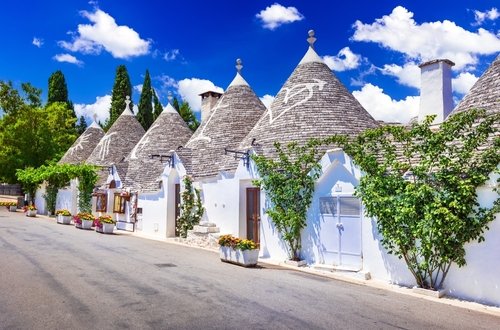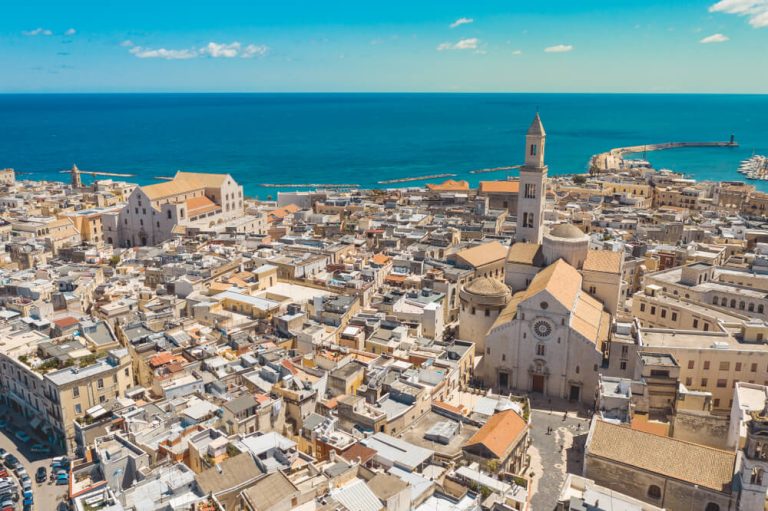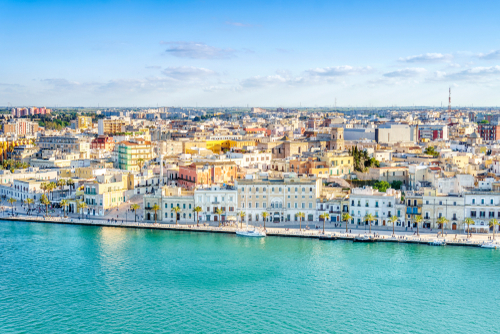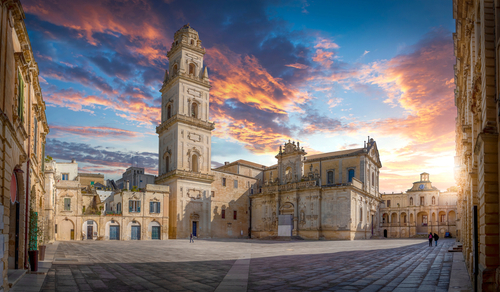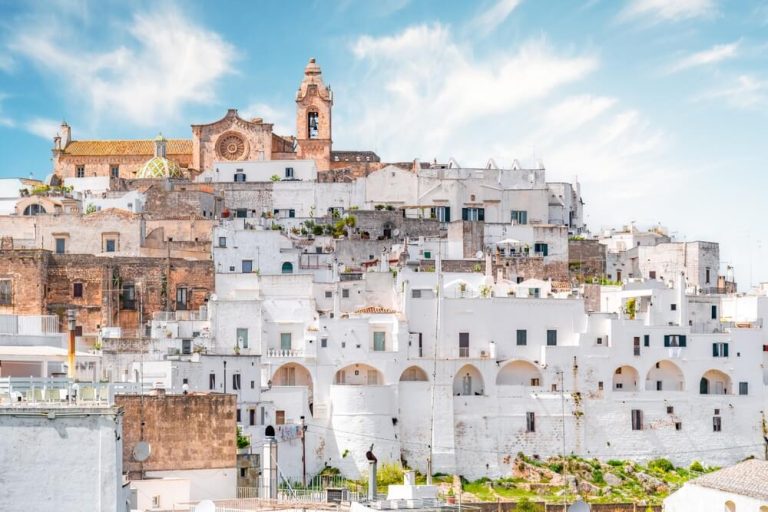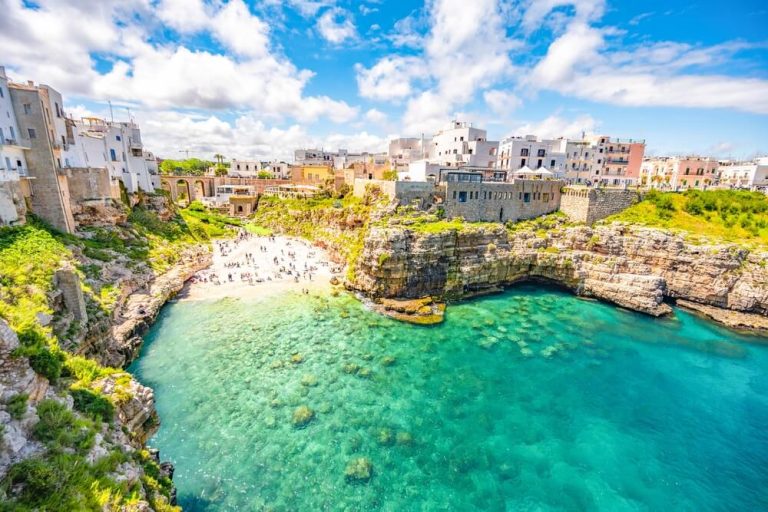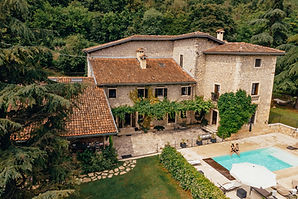Puglia
Travel Guide
Everything you need to know
Where is Puglia
Puglia is a region located in the heel of Italy’s boot. Incidentally, you may see the region referred to as Apulia or Puglia – they’re one and the same! Its capital city is Bari. It is bordered by Molise to the north, the Adriatic Sea to the east, the Ionian Sea to the south and by both Basilicata and Campania to the west. Puglia itself is divided into six separate provinces – Bari, Barletta-Andria-Trani, Brindisi, Foggia, Lecce and Taranto. It is the seventh largest region of Italy.
Puglia is perhaps most famous for its spectacular coastline and the hobbit-like trulli that are nestled within its charming towns and villages as well as across its swathes of stunning countryside. Affectionately still referred to as ‘the garden of Italy’ and the ‘breadbasket of Italy’, this rural landscape produces over 40% of Italy’s olive oil and is also among the top regions in Italy for the production of durum wheat (used to make pasta), tomatoes and almonds. But not only that. It is also a main contributor to Italy’s wine production. In short, a Puglia villa stay promises to be a gastronomic delight!
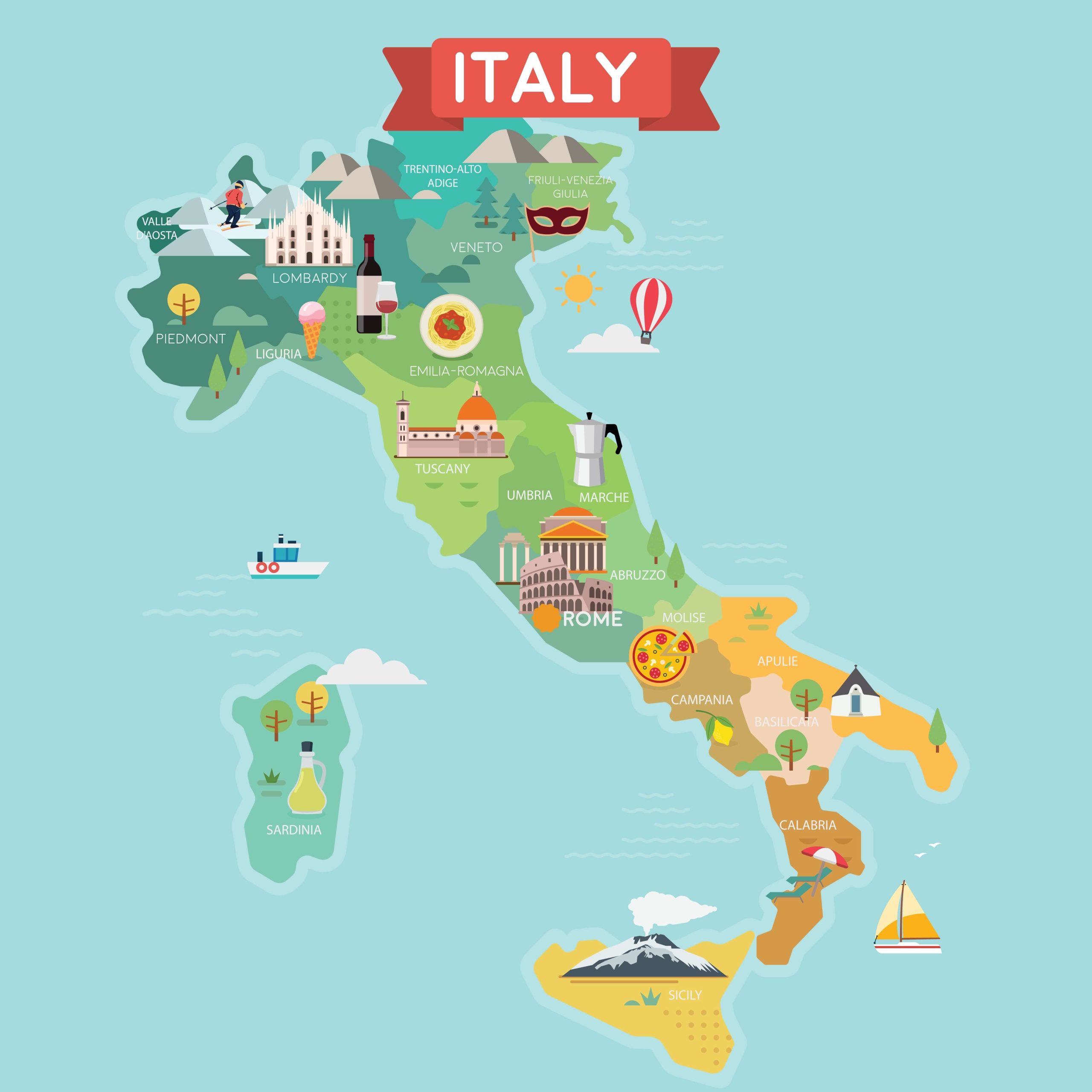
How to get there
Puglia is very easy to reach either using public transport or by car.
By Plane
Puglia is served by two main airports – Bari Karol Wojtyla Airport (BRI) and Brindisi (BDS). Please note that Brindisi airport is occasionally also referred to as Salento Airport. Both have international connections. It’s just a 75 minute drive from Bari airport in the north to Brindisi further south. Typically, British Airways, Ryanair, Easyjet, ITA Airways and Vueling fly into these airports. Most recently, in 2025, Neos also started flying direct from New York to Bari.
There is also a third airport in Puglia at Foggia. Lumiwings offers internal connections between Foggia airport and both Milan and Turin.
You can find out more information on all the flights to and from Puglia’s airports at the official Puglia airport website.
You may also want to look at flying into other Italian airports and connecting down to Puglia from there. For example, you could opt to fly into Rome and then connect from here to Puglia by train. A fast train from central Rome can reach Bari in less than 4.5 hours.
By Train
Italy is, without doubt, one of the most rail-friendly countries in the world. Using the fast train service from Rome, you can be in Bari in just over four hours. It’s even less than this from Naples. If travelling from Milan, the high-speed trains take just under seven hours, whilst from Venice it’s typically nearer to eight hours.
There are are also overnight trains from various Italian cities to Puglia. The affectionately named Espresso Salento is an sleeper service that operates for a limited period of time each Summer. Running from Rome to Lecce, it also stops at Caserta, Foggia, Bari, Polignano a Mare, Monopoli, Fasano, Ostuni, Carovigno and Brindisi.
Overnight trains also run between Milan, Turin, Reggio di Calabria and Bari. Or you could catch the sleeper train from Bolzano, Milan, Turin, Rome, Trieste or Venice to Lecce. These trains will all have regular seating but we recommend you book a sleeper cabin for maximum comfort.
Good train links throughout Europe means you can even travel to Puglia by train from the UK. Take the Eurostar from London St Pancras to Paris, then onto Bari via Zurich and Milan. The trip is not to be taken lightly though – it will take around 24 hours from start to finish. But you could of course, stop en route to break up the journey.
Find out all train times, prices and book tickets to Puglia at Trainline. Or find out more about train travel in our useful guide to travelling by train in Italy.
By Car
If you are coming to Puglia by car, then take the A14 if driving from the north. This road hugs the eastern coastline of Italy and connects Bologna with Taranto in Puglia. Alternatively, you could travel from the north on the A1 via Rome before switching to the E842 to get from west to east.
Italy does has a good road network and travelling by car tends to be easy and efficient. If you’re looking to get from A to B quickly, then it’s worth using the Italian Autostrada whenever possible. These are fast roads but you do have to pay to use them. Toll booths will either require immediate payment or ask you to take a ticket, in which case payment will be made when you exit the motorway. Payment can usually be made using either a credit card or in cash. Just make sure you choose the correct lane – telepass or biglietto. The telepass is a device that will automatically deduct the toll from your bank account. The likelihood is that you won’t have one of these so instead you should opt for taking a ticket (biglietto). You can check the official Autostrada website for more details and for guidance on routes and journey times.
By Boat
Puglia’s sea-based borders means that it’s also possible to reach Puglia by boat too. Puglia’s main ports are Brindisi and Bari. They have connections with Greece, as well as Albania, Croatia and Turkey. It is possible to travel during the day or overnight. However, journey times can be long. The voyage from Bari to Croatia typically takes around 10 and 10 hours, whilst the crossing from Greece can take anywhere between 8 and 17 hours dependent on your starting point. However, there is a faster crossing between Corfu and Brindisi which takes just 6.5 hours with Grimaldi Lines. That said, travelling to Puglia by ferry does allow you to bring your car with you.
Please note that, whilst there is also a port in Taranto, this is not used for tourism purposes. Instead, it is used for commercial and military purposes.
By Bus
Flixbus has routes from a number of major cities in Italy to approximately 20 different towns and cities in Puglia.

How to get around Puglia
Once you have arrived in Puglia, you have a few options about how to get about during your holiday. We do definitely recommend hiring a car – it will give you so much more freedom and allow you to explore parts of Puglia that may be hard to reach using public transport. However, it’s good to understand all the options open to you.
Public Transport
If arriving at Bari airport, buses go from here to Bari city centre every 20 to 30 minutes. Similarly, if arriving at Brindisi airport, you can easily reach Brindisi, Taranto or Lecce by train, bus or car.
If you’re travelling between larger towns and cities in Puglia and are looking to use public transport, we would usually recommend you opt for the train. The region has over 800 km of railway lines connecting all six provinces of Puglia. There are four regional train operators in Puglia. Trenitalia’s regional trains are operated by the Ferrovie del Sud Est (FSE) in Puglia. They connect Bari to Brindisi, Lecce and Taranto. The Ferrovie Appulo Lucane connects Bari and Murgia to Basilicata, whilst the Ferrovie del Gargano runs services in the Foggia province of Puglia. Finally, the Ferrotramviaria runs between Bari and the northern towns in the province of Bari as well as towns in the Barletta-Andria-Trani province.
We recommend you use the Trainline app for all ticket purchases and to plan your journey, not least because many of Puglia’s smaller stations no longer have a working ticket office.
That said, many of the smaller towns and villages in Puglia don’t have train services at all. As a result, you will probably also need to use the bus network if restricted to using public transport.
Travelling by bus will allow you to visit a more hidden, less crowded and undiscovered side of Puglia. Buses also often offer a cheap mode of travel if you’re on a budget. However, just to warn you, bus timetables in Puglia are typically hard to navigate and are often geared to commuters, not holidaymakers. Delays to services are also to be expected as standard.
There is no national bus network in Italy. Most buses are regional. And, even within the same region, there can sometimes be multiple companies operating. This is certainly the case in Puglia, where there are a number of public and private bus companies. You will also find that all four of the regional train companies also run their own network of buses. For example, Ferrovie del Gargano runs a bus service connecting San Severo with Vieste. And Ferrovie del Sud Est have buses that cover the area between Bari and Lecce as well as extending into Italy’s heel.
The main bus companies are SitaSud, ACAPT, STP Bari, STP Brindisi and STP di Terra d’Otranto.
The ACAPT website lists all the destinations they serve by bus. These are typically the towns and villages north of Foggia. In contrast, STP Bari runs services around Bari to towns further north as well as to Gravina and Matera in the west. But typically, most of their destinations are better served by train. STP Brindisi buses run urban services in Brindisi and Ostuni as well as out of town services throughout the province. But these buses are similarly not ideal for holidaymakers. This is because the timings of their service is more aimed at locals, school children and commuters.
In short, the bus network in Puglia is confusing, complicated and not always conducive to holiday travel. That said, in order to try and simplify the bus network, a Consortium of Transport Companies of Puglia was created – COTRAP. This is by no means the perfect site – not all routes will be included on here for a start. But it is worth a look if you are planning to travel by bus in Puglia.
Renting a car and driving
There are a number of benefits to driving a car in Puglia. Not least, it allows you to explore Puglia at your own pace. It also enables you to fully discover Puglia’s picturesque rural landscape and its smaller hilltop towns and villages. Expect to enjoy breath-taking panoramas around every corner! All local airports are well served by both international and local car rental companies.
There are six types of roads in Puglia – the motorway (autostrada), the state roads (superstrada), the regional roads (strade regionali), the provincial roads (strade provinciali), municipal roads (strade comunali) and strade bianche. These are white gravel roads, often found in rural areas. It can often be that the final approach to your Puglia villa rental will be along one of these strade bianche.
The principal motorway in Puglia is the A14 which actually runs over 700 km from Bologna in the north to Taranto in southern Puglia. However, running from Naples in the west to Canosa di Puglia in the east is the A16.
The main superstrada (SS) in Puglia is the SS16. This road runs along the Adriatic coast and connects Bari, Brindisi, Lecce and Otranto. Other main highways include the SS7 and SS603 between Brindisi and Taranto as well as the SS101 between Lecce and Gallipoli, but there are a number of others.
However, when driving in Puglia, we often recommend that, instead of taking the motorway, you take the regional or provincial roads. It does mean that it will take longer to get from A to B, but you will be rewarded with a more authentic journey. One of our favourite routes include the scenic coastal road between Santa Cesarea Terme and Santa Maria di Leuca. This has views as stunning as those of the more famous Amalfi Coast but without the traffic. We also love driving along the smaller roads inland in the beautiful Valle d’Itria.
That said, there are a couple of caveats when it comes to driving in Puglia. The first is that much of Puglia is rural. As a result, use the smaller roads and you should be prepared to encounter slow-moving agricultural vehicles as well as tiny ape (three wheeled utility vehicles). The narrow roads means it’s not always possible to overtake. Instead, just relax and enjoy the slower pace!
Drivers should also be aware of Zona Traffico Limitato (ZTL). These restricted traffic areas prohibit non-resident vehicles from entering. There are over forty towns and cities in Puglia which have a ZTL. These include Altamura, Bari, Brindisi, Ceglie Messapica, Foggia, Gallipoli, Gravina di Puglia, Lecce, Manduria, Monopoli, Nardo, Ostuni, Otranto, Polignano a Mare, Porto Cesareo, Taranto, Trani, Troia and Vieste as well as others.
The aim behind ZTLs was to reduce pollution and limit damage to streets and buildings in the historic centres. However, they have also managed to create a much nicer experience for those exploring these historic centres on foot. The ZTL tend to be active during certain hours so you need to read the signage carefully.
Every entrance to a ZTL will be clearly signed indicating that you are entering a restricted traffic area. These signs consist of a white circle with a red border on a white background. The words ‘Zona a Traffico Limitato’ is clearly written above the circle, whilst below there will be information regarding the timing that the restrictions are in place. For example, a sign stating 8.00 – 20.00 would indicate that the restrictions are in place between 8 o’clock in the morning and 8 in the evening. Your rental car will not have a permit to access these areas. Nor will your own vehicle. The only exception will be if you have booked accommodation within a ZTL and your Puglia villa or hotel provider has already informed you that you are able to enter the area and have already taken a note of your car registration plate. If in doubt, check with them before entering.
Entrances will also be marked by security cameras. These will immediately record your registration number if you enter and a fine will be issued should you be breaking the restrictions. In fact, you can be fined multiple times – each time you pass a security camera, you can get a new fine. Since fines can be up to €300, it’s a costly mistake to make! Don’t think it’s OK to enter if you happen to see other vehicles inside the area either. Residents are normally allowed to enter as is public transport. And don’t be fooled by what your GPS or SatNav system might be telling you to do. They don’t always inform you that you’re entering a restricted traffic zone.
Finally, many of the streets in Puglia are narrow and don’t provide much room for cars to pass. As a result, we recommend hiring a small a a car as is comfortable.
By Bike
Cycling is another great way to explore Puglia. Much of the region is relatively flat, making getting around by bike relatively straightforward. And exploring the region on two wheels is the perfect way to slow down the pace of your sightseeing. We’re big believers in the benefits of slow travel at Bookings For You and cycling is the perfect way to travel slowly.
Of course, you should always be vigilant when sharing the road with car users. However, many cities in Puglia have marked bike lines. Puglia also has a number of bike routes that will take you all over the region. Some of the main routes include the EuroVelo 5. This route is actually over 3000 km long and passes through the whole of Italy however the section in Puglia takes you from Taranto to Brindisi. There is also the Ciclovia dell’Acquedotto which runs from Cisternino to Ceglie Messapica in the heart of the Valle d’Itria.
Even when there aren’t formal bike routes, many of Puglia’s roads are narrow, country lanes, perfect for cycling.
Cities and Towns in Puglia
Puglia is filled with charming villages, towns and cities. Some of the most famous of these are Alberobello, Bari, Brindisi, Polignano a Mare, Ostuni, Martina Franca, Cisternino, Lecce, Locorotondo and Gallipoli.
Bari
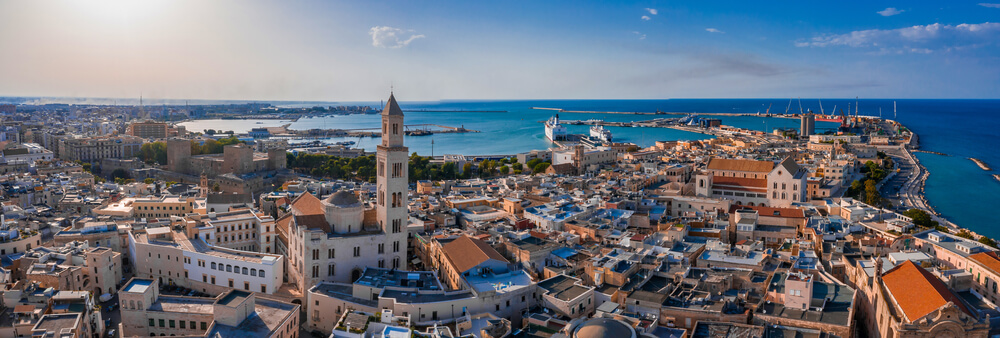
Introduction to Bari
Bari is the capital of the Puglia region. Its sights can easily be seen in a day, but if you can spare the time, we recommend you stay overnight. Like many of Puglia’s towns and cities, life only starts mid afternoon so to really appreciate the atmosphere and life as a local, it’s best to spend a full 24 hours here.
Further south in Puglia, Lecce is often described as the Florence of the South. If this is the case, then we would probably compare Bari to Bologna. It is more urban than many of Puglia’s cities. And, with a strong student population thanks to its large university, it has a livelier nightlife.
The town is split into two main areas – the older Bari Vecchia (which is oozing in history and charm), and the more modern Murat area closer to the train station. This is where you will find all the shopping as well as high end cafes, bars and restaurants.
Many of the must-see attractions in Bari are in the historic centre. These include the Basilica di San Nicola, home to the relics of Saint Nicholas, and a popular site for pilgrims. A short walk from here is Bari’s 12th century castle, close to which you will find the affectionately named Strada delle Orrecchiette. It is so-called as it is lined with ladies making and selling this ear-shaped pasta. The most famous of these Bari pasta grannies is Nunzia who even appeared in Vogue, but there are numerous others. Also in Bari’s historic centre is the Cathedral and its central square – the Piazza Mercantile. You can still see the Colonna della Giustizia here where back in the 16th century, debtors would have been tied and whipped as punishment.
Bari also has a number of museums worth visiting. For example, the Palazzo Simi is ideal for exploring Bari’s underground past, whilst the Museo Archeologico di Santa Scolastica looks at Bari’s history as far back as the Bronze Age.
Tips for navigating the city
Bari airport is just 9 km from Bari’s city centre. Either opt to catch the number 16 bus which will get you to the heart of Bari in 40 minutes or catch the train which will get you there in half the time. Incidentally, parking is extremely limited in Bari, and driving in the city can be stressful, so we recommend you avoid coming by car if you possibly can.
Despite being Italy’s third largest city behind Naples and Palermo, it is easy to explore Bari on foot. Certainly, within Bari Vecchia, everything is within easy walking distance. Its main sights – Bari Cathedral, Castello Svevo and the Basilica di San Nicola, are all connected by narrow, winding streets which can really only be navigated on foot. The seafront promenade is also best discovered on foot.
However, if you do need to rest those legs, Bari does have an efficient bus network run by AMTAB. Or there is also an excellent bike sharing service in Bari. Using the VaiMoo app, you can navigate your way along the main cycle paths in Bari. The first 30 minutes are free (or €0.50 for an electric bike). Just pick up and drop off at the nearest collection point.
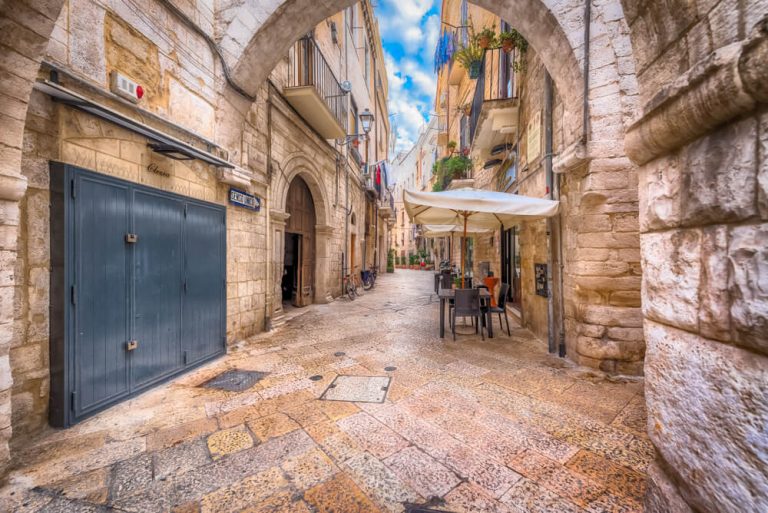
Accommodation and dining recommendations
If staying overnight in Bari, there are plenty of accommodation options on offer, suitable for all budgets. These include hotels in Bari, B&Bs as well as Bari apartments too. Just be aware that, whatever option you choose, you will need to pay a tourist tax. In Bari, the tourist tax applies to all accommodation but the amount depends on the type and rating of your hotel or holiday rental. Typically costs are between €1.50 and €4 per person per night. The tax applies to all those aged 14 and over and it is applied for a maximum of four consecutive nights. Alternatively, given how easy it is to reach Bari by public transport, you could also opt to stay in a Puglia villa in the Bari countryside.
It’s certainly worth spending at least one night in Bari if you can during your Puglia villa holiday. That way, you can also make the most of the wonderful bars and restaurants in the city.
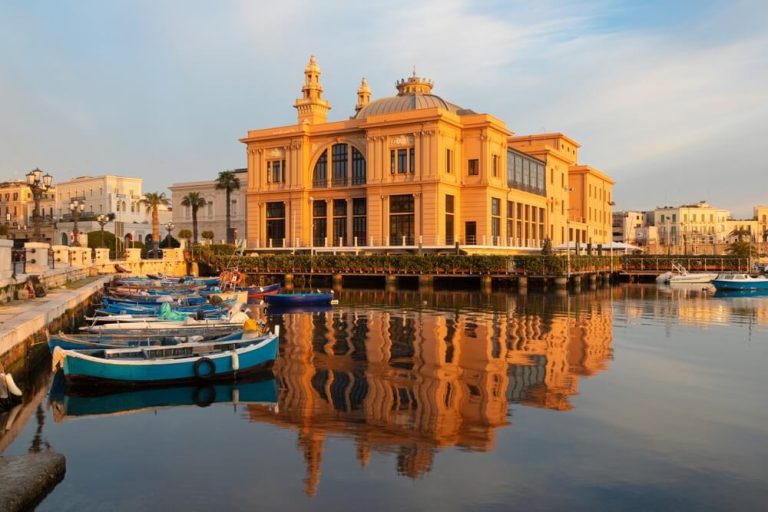
One of our favourite classic dishes to enjoy at lunchtime is the famous octopus sandwich. Sold from hatches and bars throughout the city, it is a delicacy not to be missed. The other street foods in Bari that you absolutely must try are the Focaccia Barese and the Panzerotto. This is probably most accurately described as something akin to a small calzone. Suffice to say, it’s delicious. The best place we have found to enjoy all three of these is Mastro Ciccio.
For the best orecchiette we’ve ever had in Italy, head to Orecchietteria San Nicola. Or for a contemporary, fine dining experierence opt for La Bul.
Alberobello

Introduction to Alberobello
Alberobello is arguably Puglia’s most famous town. Home to over 1500 trulli, it’s one of a number of UNESCO World Heritage sites in Puglia. It is also one of Italy’s borghi piu belli (most beautiful towns in Italy). Trulli are buildings of dry-stone construction, made from limestone that date as far back as the 14th century. They typically have thick whitewashed rectangular bases with conical shaped roofs, small windows and a doorway. If you want to find out more about the trulli in Puglia, visit the Trullo Sovrano. This is the largest trullo in Alberobello. Arranged over two stories, it’s now a museum. The Museo del Territorio will also give visitors the opportunity to find out more about the history of these buildings and specifically to understand how people would once have lived in them.
Alberobello is split into two parts – Rione Monti (where there are 1030 trulli) and Rione Aia Piccola with 590 trulli. We recommend you start your visit to Alberobello in the Rione Monti. Enjoy a stroll through the main street here and enjoy time in the boutiques and shops that line it.
We also recommend you visit the Church of Sant’ Antonio. This is the only trullo church in the world. We also recommend you visit one of Alberobello’s other churches – the Chiesa di Santa Lucia – even if you only visit to admire the view of the trulli from the viewing platform here. Visit in the morning if you can so you can get some great pictures before the sun goes over the trulli, or at sunset.
Another great view of the trulli in Alberobello is at the Villa Comunale Belvedere park. Or, if you fancy enjoying an aperitivo with a view, head to the Bar Riona Monti. Incidentally, if you see a sign outside any of the trulli saying casolare panoramica, you will be able to enjoy the view from their rooftop terrace in return for purchasing an item from their store.
Find out more in our Alberobello travel guide.
Tips for navigating the city
Alberobello is super easy city to discover on foot, especially as the historic centre is a Limited Traffic Zone (ZTL). The trulli are within an area of approximately 27 acres. And two or three hours will be more than sufficient to discover the town. However, if you can, we do recommend staying longer.
If arriving by car, there are three well-signposted paid public parking areas near the Rione Monti. Look out for the blue lines which indicate paid parking for visitors. There are also a few private parking areas. These include a car park at Via Cadore 12, as well as two on Viale Indipendenza. If you are happy to park a bit further out of the centre of town, you can find free parking at Viale Putignano. It is about a 10-15 minute walk from here to the trulli from here.
However, despite the number of car parks, due to the sheer number of visitors to Alberobello, parking is not always easy, particularly in peak periods. We recommend you arrive early to secure a parking spot. Alternatively, you may also want to consider coming by bus or train.
The train station in Alberobello is a 10 minute walk from the historic centre of the town. It takes 2 hours to reach Alberobello by train from Bari and involves a change at Putignano. There are regular direct trains to Alberobello from nearby towns such as Martina Franca and Locorotondo run by Ferrovie Sud Est, or from towns such as Monopoli.
The bus service from Bari to Alberobello takes around an hour. All buses arriving in Alberobello stop at Via Cavour.
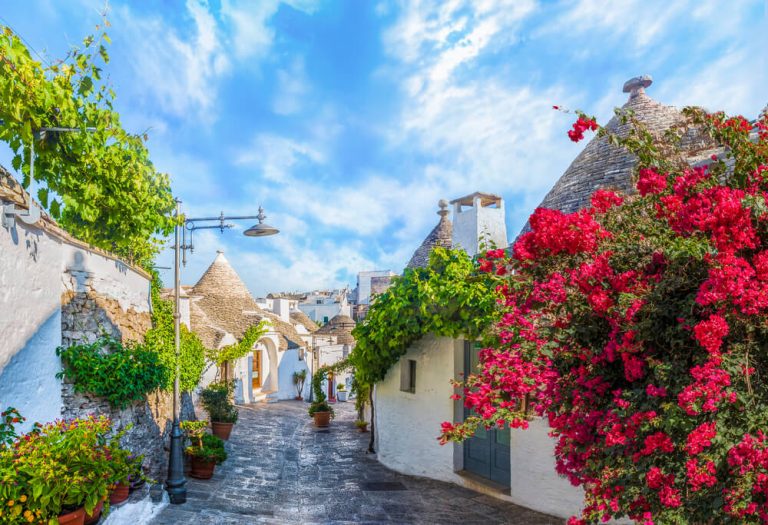
Accommodation and dining recommendations
If staying in Alberobello, you can choose between a hotel in Alberobello, B&B or even a villa in Alberobello. We do recommend staying overnight if you possibly can. The busiest times of day in Alberobello are between 10 and 4 o’clock. If you stay for the evening you are going to be much more likely to explore Alberobello without the crowds.
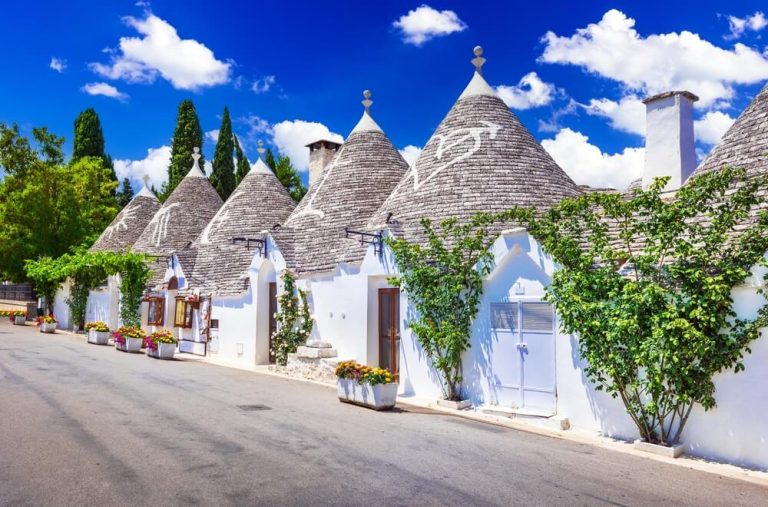
If you want to sample some typical dishes of the region, then our favourite restaurant in Alberobello is the La Cantina. With limited seating, it is advisable to book a table in advance.
If you’re looking for a lighter bite, then Alberobello is also home to a unique sandwich. It was invented in 1966 by Pasquale dell’ Erba and is aptly called the Pasqualino. Tuna, capers, salami and cheese are sandwiched in rosetta bread. Most deli counters or grocery stores should be able to make you one in Alberobello but our favourite place to enjoy it is Focacceria La Lira. Incidentally, this place also serves up the most delicious focaccia and pucia.
Our final recommendation is Paco Wines enoteca. This is perfect for an aperitivo. First and foremost, it sells wine but we recommend you enjoy a glass or two with one of their cheese or meat boards.
Cisternino
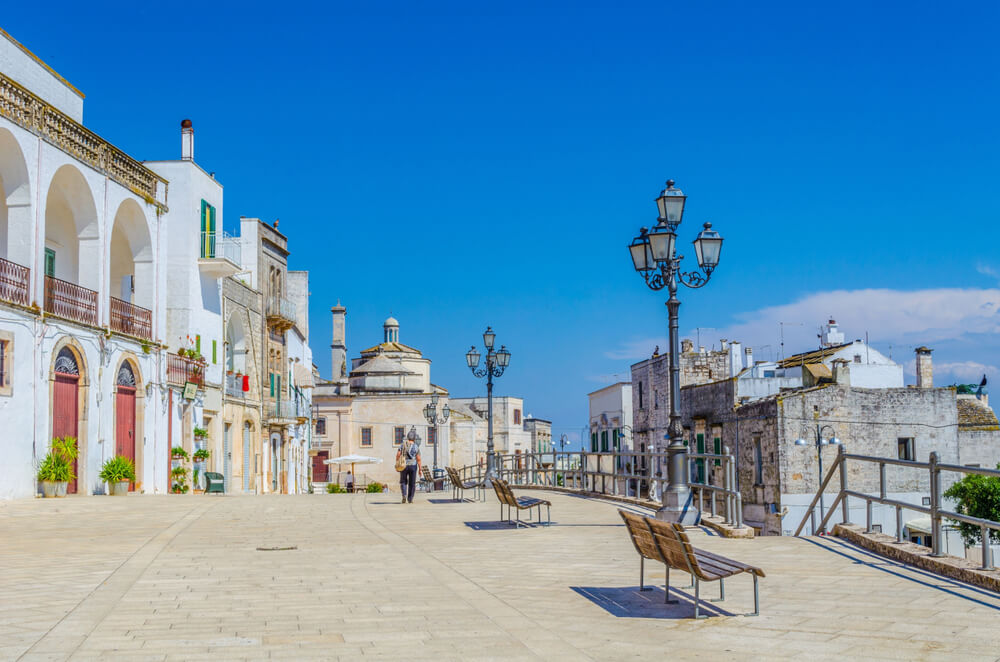
Introduction to Cisternino
Cisternino is one of 14 borghi piu belli in Puglia. Once you have moved beyond its bland outskirts to the historic centre, it’s easy to see why. Brightly coloured flowers are festooned over every balcony, contrasting with the whitewashed walls of its buildings. Its elevated position 400 metres above sea level also means that it enjoys terrific views over the rolling Apulian countryside.
Enter through the most impressive of Cisternino’s gates – the Porta Piccola – and simply meander through its charming alleyways and lively squares. Visit some of Cisternino’s historic buildings as you pass by. These include the Church of San Nicola di Patara, the Palazzo Amiti, the 13th century 17 metre high Norman-Swabian tower (Torre Grande), the Baroque Church of San Cataldo and the Sanctuary of Madonna d’Ibernia which sits 3 km from the historic centre. And then relax and enjoy a drink in either the Piazza Vittorio Emanuele or in the Villa Communale, which is the main park in the town.
Cisternino is definitely a very instagrammable town in Puglia. Keep an eye out for the many swings around the town and for the numerous quotes and poems written on the walls.
Read our Cisternino travel guide to find out more.
Tips for navigating the city
Cisternino Citta is the train station closest to the historic centre of Cisternino. It’s a 20 minute walk from here to the heart of the town. Incidentally, avoid Cisternino station on the main train line between Bari and Brindisi – it is miles from the town! If you are using the main train line, you could opt to disembark in Fasano and then take the bus from here to Cisternino.
If coming by car, it can be difficult to park in Cisternino, particularly during one of the many festivals that it hosts. The most popular of these is the Festa di San Quirico in August. Cisternino also hosts events as part of the International Music Bands Festival which is held in the Valle d’Itria each July. And there are a number of food festivals too including the Chestnut Festival in October.
However free parking can be found near the train station on the Via Antonelli and the Via Arenazza.
Once there, it only takes 1-2 hours to see the main sights in Cisternino. That said, we recommend you allow 3-4 hours to enjoy the town at a slower pace.
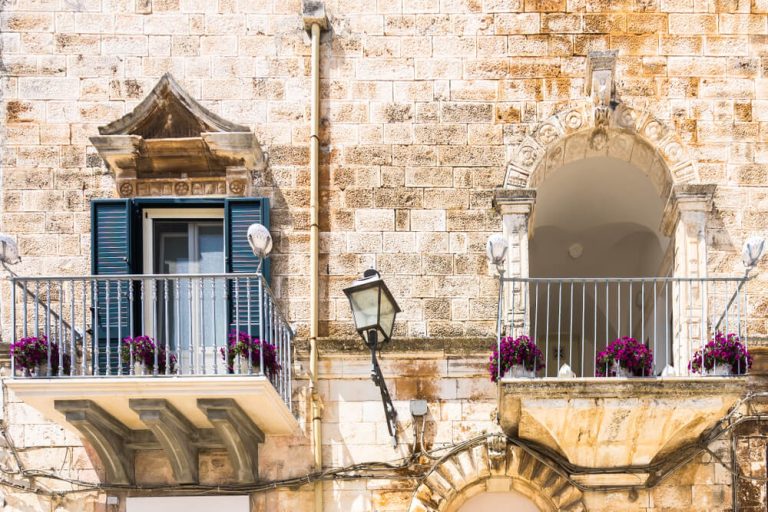
Accommodation and dining recommendations
We recommend you find a Puglia villa near Cisternino rather than staying in the centre of the town. You’ll enjoy more private space.
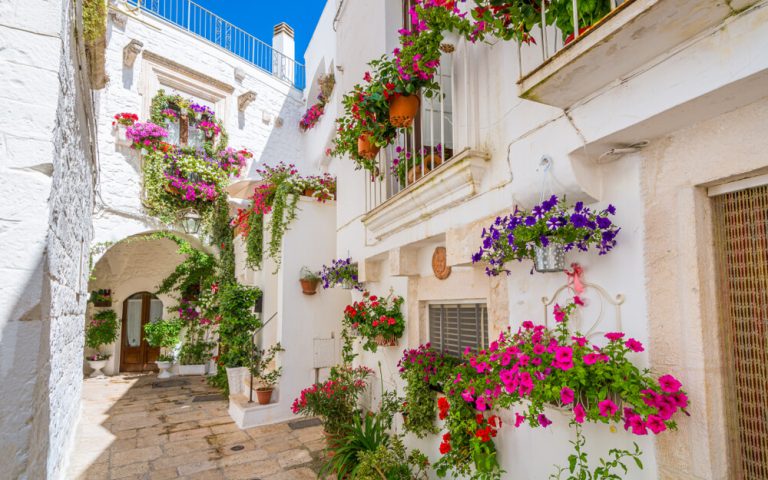
Cisternino is famous for its barbecuing butchers known locally as fornelli pronti. These butchers shops offer a grilling service. Simply pop in, choose your meat and they will cook it up for you on their open air barbecue. You can then tuck in straight away, either at their outdoor seating area if they have one, or on a nearby bench. We recommend you opt for the bombette – pork meat rolled and wrapped around ingredients such as ham and cheese. Zio Petro is a recommended option if you want good food with seating on site, as is La Rosticceria L’Antico Borgo.
To stock up on the freshest local ingredients to cook up a feast in your Puglia villa, head to Cisternino on a Monday or Thursday morning to enjoy the lively weekly market.
Lecce
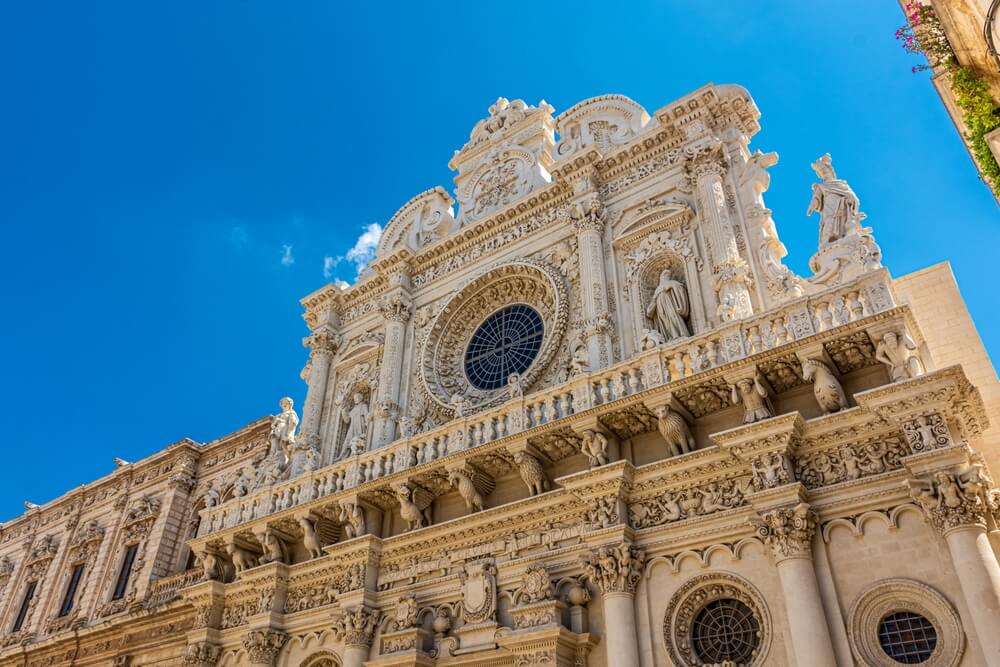
Introduction to Lecce
Affectionately referred to both as the Florence of the South and as Puglia’s Baroque Jewel, Lecce has quite a different vibe to other towns and villages in Puglia. Its historic centre is bursting with charming piazzas and beautiful piazzas, bustling cafes and restaurants and interesting independent shops and boutiques.
Worth seeing in Lecce is the Roman amphitheatre, that sits beneath the statue of Saint Oronzo (Lecce’s patron saint) in the Piazza Sant’ Oronzo. Built in the 2nd century BC and excavated after WWII, this would once have hosted gladiator battles watched by up to 20,000 spectators.
Lecce also has a number of churches worth visiting. Lecce’s Duomo dates back to 1144 but the 70 metre tall bell tower was a later 17th century addition designed by Giuseppe Zimbalo. Enjoy the elevator trip up the bell tower to enjoy the views over the city from the top. And spend time people watching in one of the cafes that line the Piazza del Duomo.
Just as beautiful is the Basilica di Santa Croce, widely regarded as the most beautiful example of the Baroque style anywhere in Italy. Its facade is incredibly intricate and it is not surprising that the church took 150 years to build. The interior is just as stunning with a carved wooden ceiling not dissimilar to the Pantheon in Rome.
Other Baroque churches in Lecce include the Churches of San Matteo, Santa Chiara and San Giovanni Battista. And the Church of Saints Niccolo and Cataldo is a fascinating mix of both Norman and Baroque styles.
Other buildings in Lecce include the Palazzo dei Celestini, a Zimbolo masterpiece. This was once a convent but is now the seat of local government. On the other side of this sits Lecce’s main park – the Villa Comunale which is the perfect spot to enjoy a passeggiata. And, last but not least, is the Castello di Carlo V. This castle was originally built by the Normans in the 12th century but was enlarged extensively by the Holy Roman Emperor Charles V. It can claim to be Puglia’s largest castle. Used as a prison, military barracks and a court over the years, these days it hosts cultural and artistic events. It is also where you will find Lecce’s papier mache museum.
Incidentally, you can usually expect to find Lecce sleepy during the day but it comes alive from the late afternoon and early evening onwards.
Tips for navigating the city
Lecce is easy to reach by train. The train station in Lecce is Piazzale Oronzo Masari. Situated 1.3 km away, it is a 15 minute walk from the historic centre. The journey by train from Brindisi to Lecce is just 30 minutes and from Bari just 1.5 hours. Direct trains also run to Lecce from Foggia and Ostuni. You can also reach Lecce by bus. Again, the main bus terminal is a little way from the historic centre.
If coming by car, you will also need to park outside the historic centre but there are plenty of options whatever direction you enter the city. There are car parks in Lecce on the Via Antonio Gramschi and Via Vincenzo Balsamo as well as in the Foro Boario in the Piazza Carmelo Bene. The parking on the Viale dell’ Universita in Lecce is also very convenient as is the parking on the Via Benedetto Croce. All are an easy walk into the historic centre. Even closer to the centre of Lecce but still outside the ZTL is the Parcheggio Torre del Parco on Via Adua, the car park on the Via Liborio Salomi and the Parcheggio Piazza Mazzini.
Once in Lecce, it’s not necessary to have a car. The city is easily explored on foot.
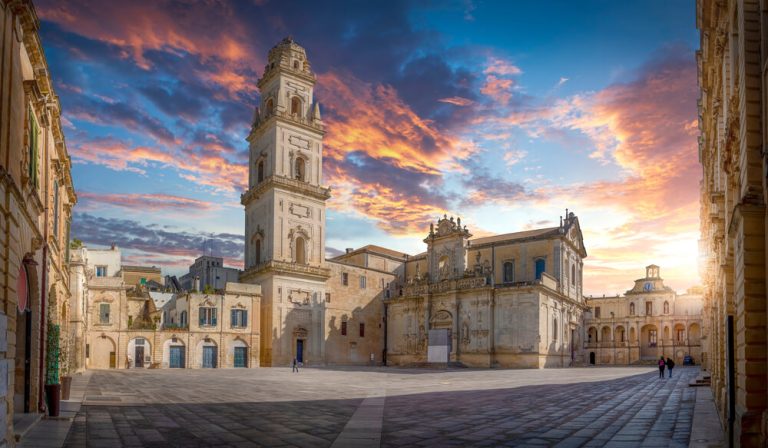
Accommodation and dining recommendations
Lecce has a number of culinary specialities. These include the refreshing Caffe Leccese. Also referred to by locals as caffe in ghiaccio con latte di mandorla (iced coffee with almond milk), it’s deliciously refreshing on a hot Summer day in Puglia. We recommend you have one for breakfast with a pasticciotto – a scrumptious flaked pastry treat, most commonly filled with custard but other fillings are available. For lunch, grab a Rustico Leccese from a local cafe. This is a savoury pastry round, usually filled with tomato and mozarella. But again, other stuffings are available. Other street foods in Lecce include pucce. A puccia is a grilled sandwich made from bread probably most comparable to pitta.
In our opinion, the best cafes in Lecce to try puccia are L’Angolino di Via Matteotti and Antica Pucceria Giannone dal 1941. In business for over 80 years, Giuseppe is the 3rd generation owner of this fantastic sandwich business. Stamp your own mark on the place by leaving a handwritten review on the wall when you’re there!
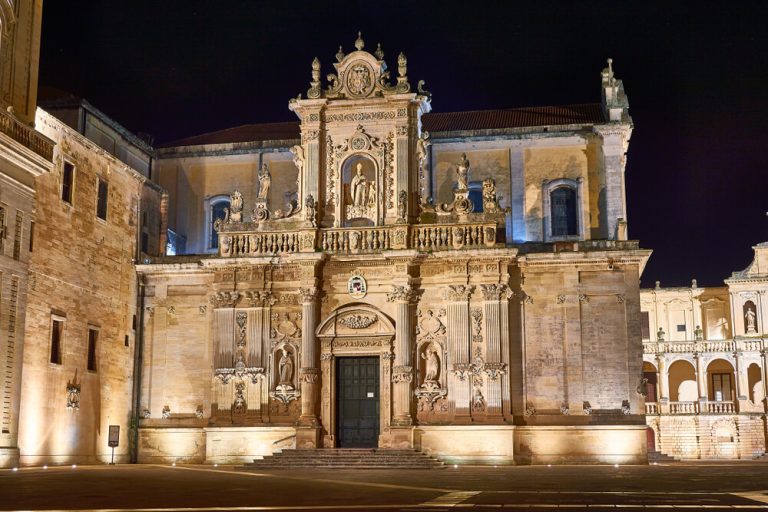
You can also buy sandwiches at Pizza & Co in Lecce. However, for us, this is the place to enjoy the best pizza in Lecce. Informal, it’s ideal for a quick slice of pizza in between seeing the sights. Finish off your meal with a gelato from Baldo Gelato, our favourite gelato shop in Lecce.
It’s not all street food in Lecce though. There are numerous fine dining options in Lecce as well. Our recommendations would be Gimmi or Duo if you’re looking for more formal fare.
If staying in Lecce, opt for a hotel or B&B in Lecce or a Puglia villa rental.
Locorotondo
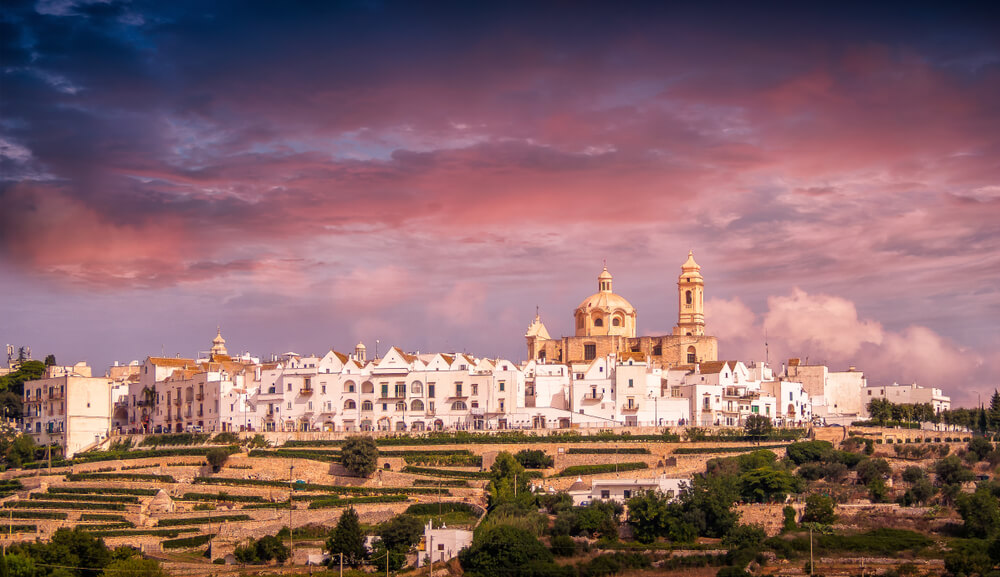
Introduction to Locorotondo
The smallest (but arguably prettiest) of the Puglia towns and villages in our Puglia travel guide, Locorotondo takes its name from the circular plan of the town. Nestled between Ostuni and Alberobello, it’s not dissimilar to Ostuni with its white-washed walls, but its buildings are very distinct from those in Alberobello. Its tall, narrow, rectangular shaped houses (cummerse) with their pointed gabled roofs contrast completely with the trulli nearby. Often affectionately referred to as the ‘balcony of the Valle d’Itria’ thanks to its elevated hilltop position and wonderful views over the surrounding valley, Locorotondo is a picture perfect town, where window boxes festooned with flowers contrast with the whitewashed buildings behind. Incidentally, for the best views, head to the Lungomare where in the valley below you will see olive groves and vineyards dotted with trulli. Or, to enjoy a meal and to sample the local wine whilst enjoying the view, head to Pavi Wine restaurant.
The charm of visiting Locorotondo is just to spend time wandering through its narrow streets and alleyways. If you’re looking for a holiday souvenir from your Puglia villa holiday, then there are some wonderful boutiques here selling local and handmade goods. However, it’s also worth visiting some of the most notable churches in the town. These include the Romanesque Church of the Madonna della Greca, the Church of San Rocco and the early 19th century Church of San Girgio.
We recommend you also visit the Palazzo Morelli in Locorotondo. A superb example of the 18th century Baroque style, visitors can enjoy a guided tour of the artworks on display inside.
And, of course, just stop and relax in one of the squares or cafes. The Piazza Vittorio Emanuele is the liveliest of the town’s squares.
Find out more about Locorotondo in our A to Z guide to the towns and villages of Puglia.
Tips for navigating the city
Locorotondo does have its own train station. It is located an 11 minute walk from the historic centre (although please note this is an uphill walk). Trains run direct from other nearby towns such as Alberobello and Martina Franca to Locorotondo but, if coming from Bari, you would need to change trains in Putignano. Instead, you might want to consider taking a bus from Bari which is far quicker taking 1 hour and 20 minutes.
The centre of Locorotondo is a ZTL (Limited Traffic Zone). However, you can park in the underground car park just before you reach the historic centre near Piazza Aldo Moro. Alternatively, you can usually find a space on the street near the train station at Via Martiri della Liberta or at Piazza Antonio Mitrano.
Be aware that the busiest day in Locorotondo is 16 August. This is the day when locals celebrate the town’s patron saint – Rocco. Events culminate in a spectacular firework display at midnight.
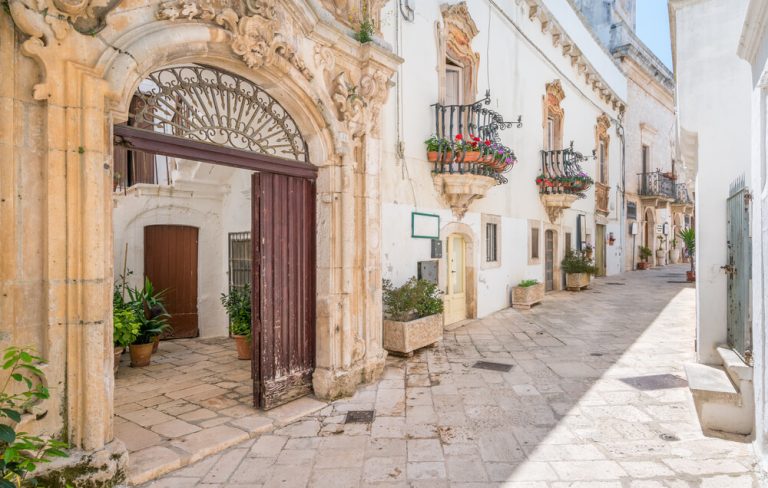
Accommodation and dining recommendations
In the heart of the Valle d’Itria, situated between Ostuni, Fasano, Martina Franca and Alberobello, Locorotondo is the ideal place to stay in Puglia. Opt for a Puglia villa in the countryside just outside Locorotondo. Or instead, find a B&B or hotel in the heart of Locorotondo at Trip.com. Just be mindful that, during the Summer months, the town will be hot and it’s usually a more comfortable heat in the surrounding countryside or by the coast.
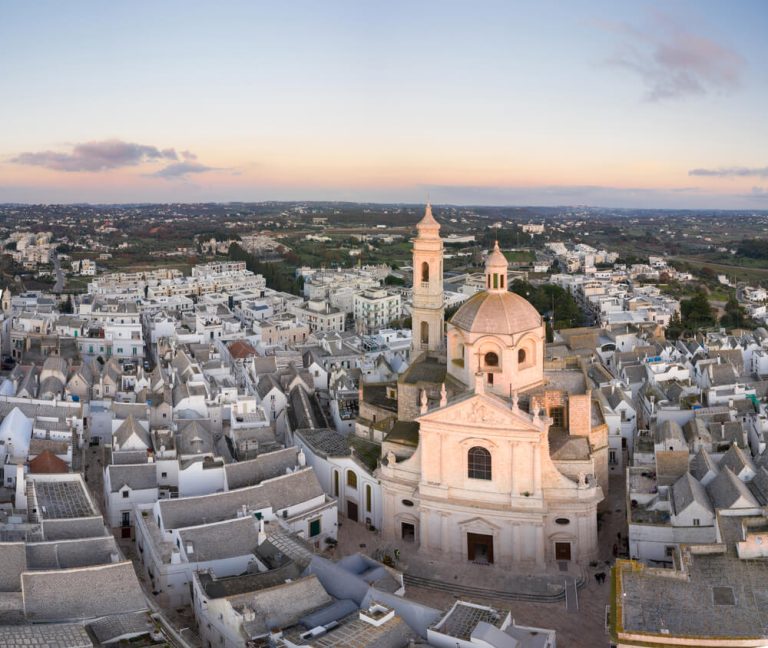
Locorotondo is famous for its production of Bianco Locorotondo DOC. This dry white wine is mostly made using the Verdeca and Bianco d’Alessano grapes. There is also a sparkling Locorotondo Spumante DOC too. The town itself offers numerous opportunities to sample both, not least at Pavi.
Besides Pavi Wine restaurant, our other recommended restaurants in Locorotondo include Il Rosone, a fantastic osteria with both indoor and outdoor seating, and L’Arco dei Tipici. This is a great place for lunch – enjoy a sharing plate of some of the best local produce such as capocollo from nearby Martina Franca, fruit and vegetables from within a 25 km radius, artisan beers as well as wine from Locorotondo itself. Controra offers a similar type of experience. Finally, try U Curdunn (meaning Locorotondo in the local dialect) for some delicious authentic cuisine.
Ostuni
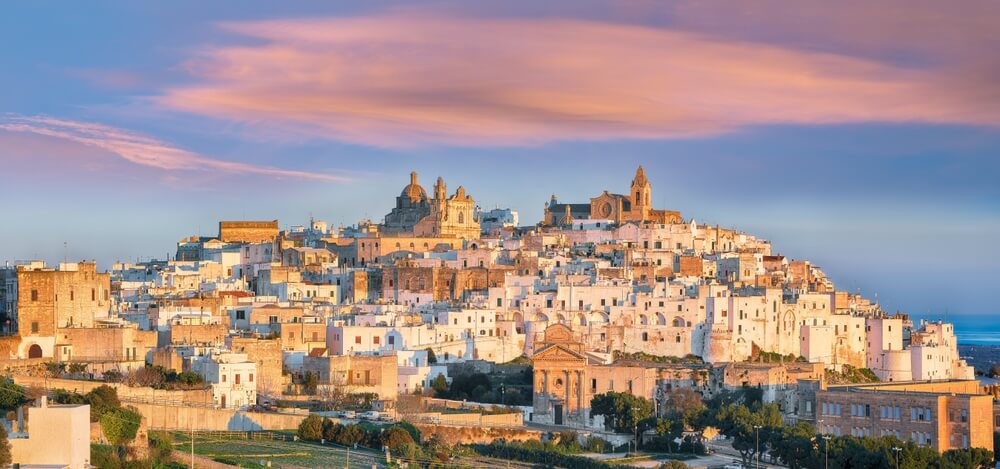
Introduction to Ostuni
Puglia’s ‘White City’ or La Citta Bianca, Ostuni has a history that stretches back thousands of years to the Palaeolithic period. However, what you see today dates between the 15th and 18th centuries.
At the highest part of the town is Ostuni’s Gothic cathedral – the Basilica Concattedrale di Santa Maria Assunta. It is famous for its elegant rose window representing the 12 months of the year, the 7 days of the week, the 24 hours of the day. However, we think its interior is even more impressive. Also in the piazza is the Palazzo del Seminario and Palazzo Vescovile.
Ostuni is a city that is best explored without a map. Just enjoy wandering around its labyrinth of paths, alleyways and staircases, allowing yourself to get lost. A walking tour of Ostuni is highly recommended to discover the best that the city has to offer. Alternatively, you can also explore Ostuni by tuk tuk.
Whilst you explore the streets of Ostuni, look out for the city’s most famous door, painted in shades of blue and green. And, if you have time, visit the city’s museums. These cover millennia of history – one exhibit is the 26,000 year old skeleton of a pregnant Palaeolithic woman who has the nickname of the Donna di Ostuni.
Discover more in our Ostuni travel guide.
Tips for navigating the city
Ostuni is easy to reach both by car or by public transport. Ostuni has its own train station but this sits just over 2 km from Ostuni itself. A bus travels regularly between the station the Cimitero Comunale and Ostuni (as well as also heading to Villanova on the coast).
If coming direct from Brindisi airport, direct trains go to Ostuni every hour or so taking just 20 minutes. From Bari airport, you will need to go to Bari Centrale first and from here you can catch a direct train to Ostuni. The journey time is approximately an hour and 20 minutes.
If coming by car, avoid Ostuni’s ZTL (Zona Traffico Limitato) by parking in one of the many paid parking areas just outside the historic centre and walking in. These include the Parcheggio Comunale Ostuni which is 10 minutes walk from the centro storico. Also convenient for parking in Ostuni is the smaller Parcheggio Tenente Specchia just 5 minutes by foot from the old town, the Parcheggio al Giardino, the Parcheggio Area Genco and the Foro Boario a little futher away. Free parking can be found on the street along Via Pietro Micca. Twenty minutes from the historic centre, this is a little further away.
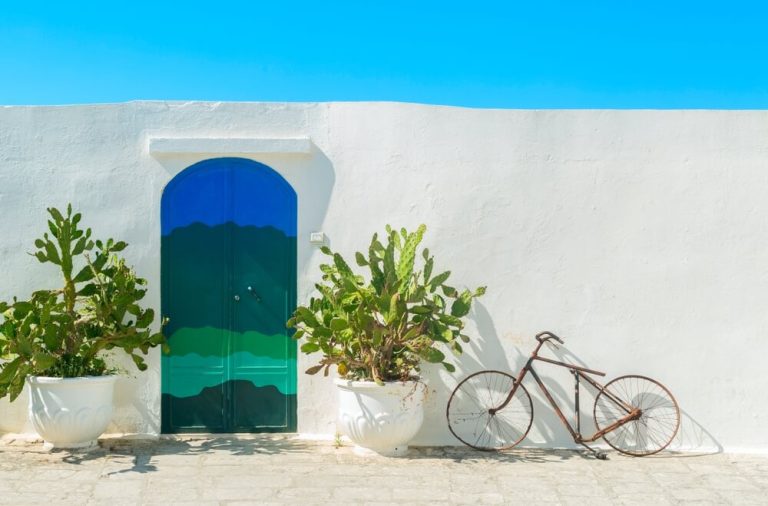
Accommodation and dining recommendations
Bookings For You have plenty of villas near Ostuni, providing the perfect base for your Puglia villa holiday. Alternatively, opt for a hotel in Ostuni, within walking distance of its bars and restaurants.
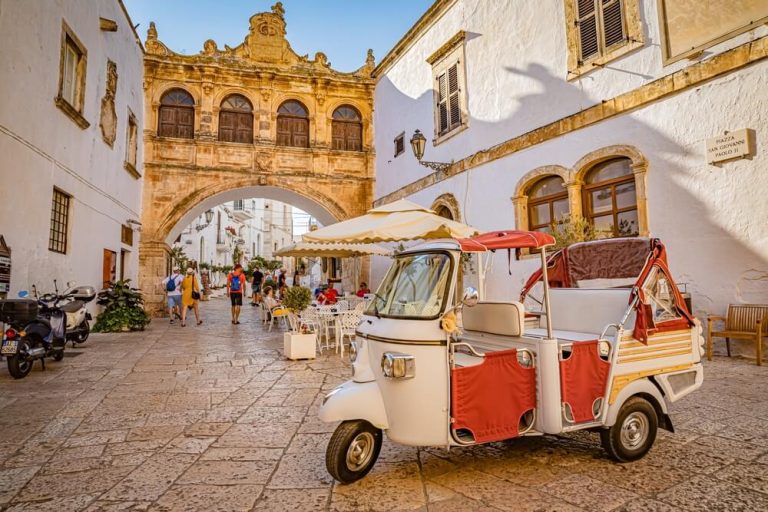
There are some fantastic restaurants in Ostuni. Osteria del tempo perso is a beautiful restaurant built into a cave and with an oven dating back to 1500! And, we think Ostuni is home to Puglia’s best gelateria. We’d make a lengthy detour just to enjoy some gelato from Cremeria Alla Scala! Next best would be Ciccio which also boasts great gelato but also the best cakes and biscuits!
For fine dining in Ostuni, head to Osteria Ricanatti. And for a wide selection of dishes including pizzas, Opera Prima is a great choice.
If you’re looking to cook up a feast in your Puglia villa rental, then head to Ostuni on a Saturday morning between 8 and 1 to shop for produce at the weekly market.
Otranto
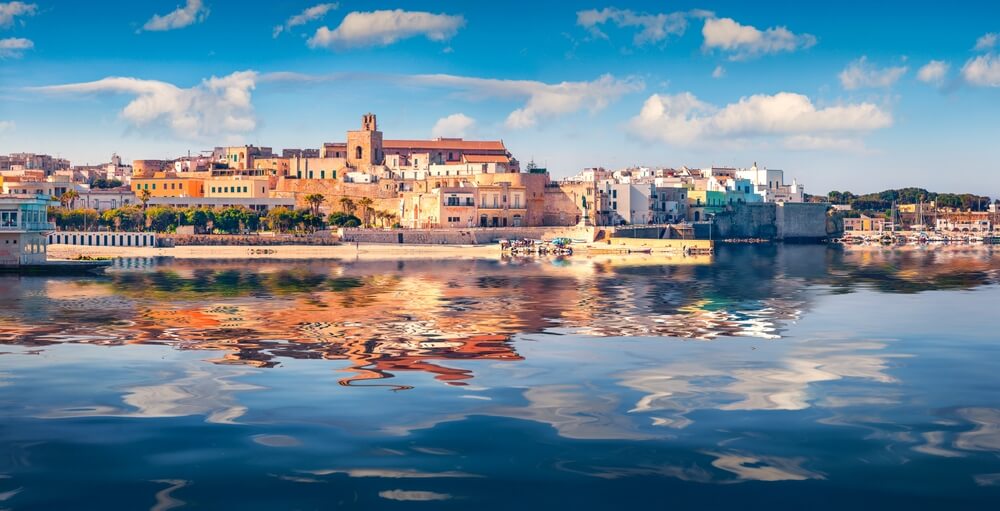
Introduction to Otranto
At Italy’s easternmost point, Otranto is a walled city dominated by the thick walls of its imposing castle – the Castello Aragonese. Half faces the cliff edge whilst the other faces inland where it is protected by a moat and keep. Enjoy a tour of the castle and marvel at the spectacular views that it boasts.
The castle gives way to a picturesque port and a series of charming sea front promenades, lined with fish restaurants and framed by sandy beaches and turquoise waters. These beaches are small and do get easily crowed in the peak Summer months. For a quieter spot, head to the beaches of Baia dei Turchi to the north of Otranto or to the rocky coves of Porto Badisco in the south.
Also just 10 km outside Otranto are the saltwater lagoons of I Laghi Alimini. A stunning natural area surrounded by pine forests and large swathes of sandy beaches, it escapes the mass of tourists and is well worth a visit.
Arguably the main attraction in Otranto itself though is the Romanesque Cattedrale dell’ Annunziata. This is one of the largest churches in Italy and is famous for its 12th century mosaic depicting the Tree of Life. Made using around 10 million tiles, this spans both the main nave and parts of the side nave. With an equally beautiful Moorish style ceiling it’s hard to know whether to look up or down!
Just five minutes walk away is the Byzantine Basilica di San Pietro, a Greek cross-shaped church home to some superb frescoes.
Find out more in our Otranto travel guide.
Tips for navigating the city
Otranto can be reached by rail. However, as it’s not located on the main line but just a branch line operated by Ferrovie Sud Est, be prepared for a slow journey. Once arriving in Otranto by train, there is an 8 minute walk from here to the centro storico.
If coming to Otranto by car, there are a number of car parks. The main parking areas near the waterfront are the Parcheggio Le Palme and the Parcheggio Sant’ Antonio. There is also parking at the Parcheggio Via Orte to the south west of the city.
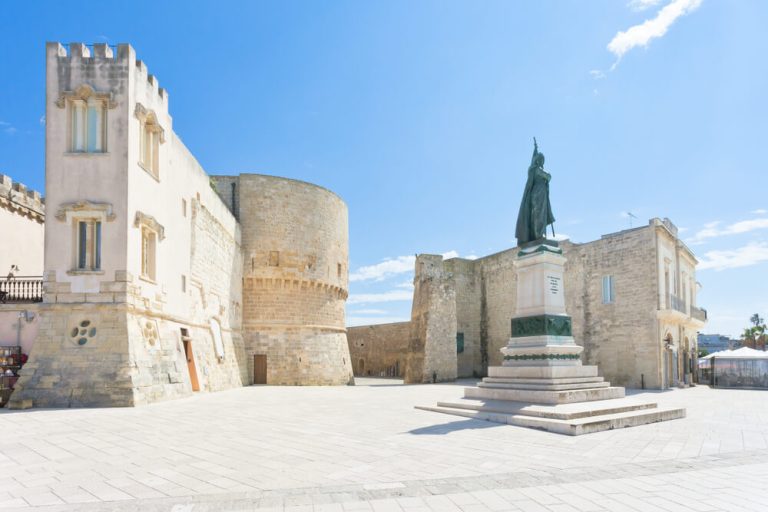
Accommodation and dining recommendations
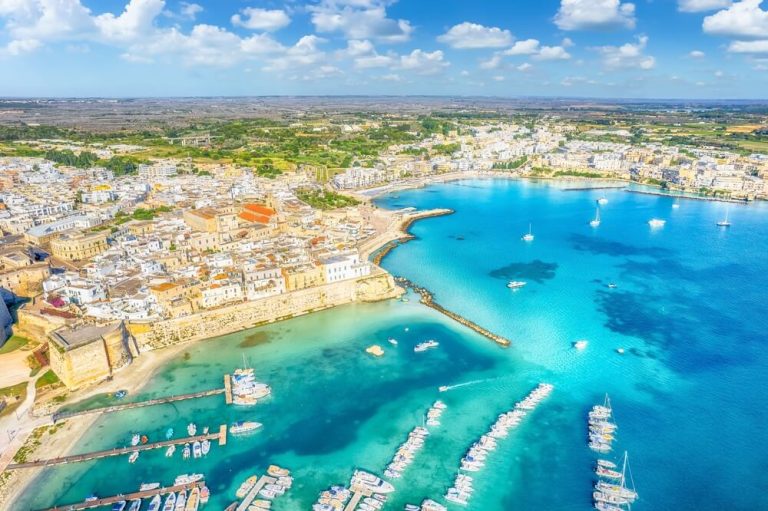
A great place for a lunchtime sandwich in Otranto is Posto Fisso, which sells fantastic pucce.
L’Ortale sits in the heart of Otranto. The setting is magical – a fairytale garden where you can sit back, relax and enjoy their wonderful selection of wines and food. Perfect for an aperitivo.
Otranto’s coastal position means it’s perfect for fish and seafood fans. One of the finest fish restaurants in Otranto is L’Altro Baffo. Other excellent Otranto restaurants serving up delicious seafood are Patronale and Ristorante Front Mare.
Polignano A Mare
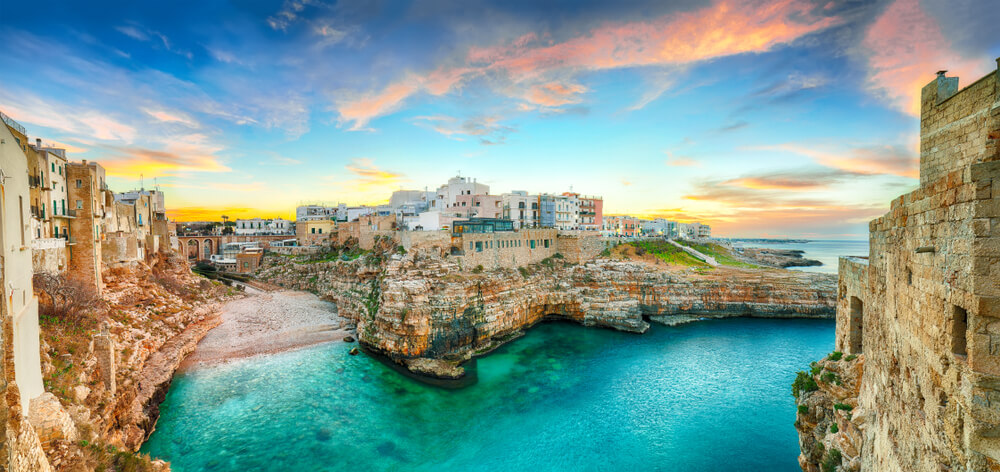
Introduction to Polignano A Mare
With origins dating back to the Greeks of the 4th century BC and subsequently the Romans, Polignano a Mare has a rich history that is still clearly visible. It’s famous for two main things – cliff diving (the Red Bull Cliff Diving championships have returned here time and time again), and the song Volare (also called Vel Blu Dipinto di Blu), performed by Domenico Modugno. The town is so proud of their famous resident that they erected a 3 metre tall statue of him overlooking the sea.
Enter the Porta Vecchia to reach the centro storico. You’ll soon find yourself in the main square – the Piazza Vittorio Emanuele II – which is home to a Medieval Clock Palace and a 22 metre high bell tower. Narrow streets lead in all directions off this square.
Modugno is not the only famous artist who lived in Polignano a Mare. The poet Guido Lupori was also a resident here. As you explore the town, look out for his poems and verses written on buildings and pavements and signed Guido il Flaneur. Of particular note is the Vicolo della Poesia, a tiny alleyway home to his poetry steps.
Whichever way you stroll in Polignano a Mare, you’re bound to eventually arrive at one of three panoramic terraces overlooking the sea. Our favourite of these is the Balconata sul Mare which enjoys 180 degree sea views and also includes views of Polignano a Mare’s famous beach.
The Cala Porto is a Blue Flag beach flanked on both sides by steep cliffs. Whilst it is certainly crowded in the Summer months, it’s a must when visiting.
Extend your visit in Polignano a Mare by enjoying a walk along the Lungomare Cristoforo Colombo. You’ll be rewarded with yet more stunning sea views as well as an opportunity to visit the town’s contemporary art museum – the Fondazione Museo Pino Pinelli.
Discover more in our Polignano a Mare travel guide.
Tips for navigating the city
The historic centre of Polignano a Mare is pedestrianised. However for those coming by car, there are parking areas nearby. Marco Polo Parking is about a 5-10 minute walk away. Or you can park at the San Francesco parking area which tends to be quieter. This is a 10-15 minute walk from the centre. If you arrive early enough in the day, you may even be lucky enough to find free parking on Via Martiri di Dogali or Via Caduti di Tutte le Guerre. And there is also a free car park at the train station in Polignano a Mare, open 24 hours a day.
For those coming to Polignano a Mare by public transport, the train station is in Viale Trieste which is 5 minutes on foot to the Piazza Aldo Moro and 9 minutes on foot to the Piazza Vittorio Emanuele II. Incidentally, if you’re coming by train from Bari, we recommend you try and get a seat on the top left hand side of the train to make the most of the views en route.
Bus companies serving Polignano a Mare include Flixbus, Marinobus and Ferrovie del Sud Est.
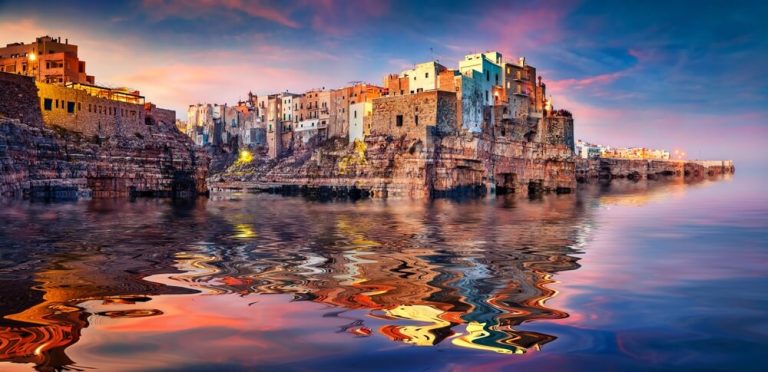
Accommodation and dining recommendations
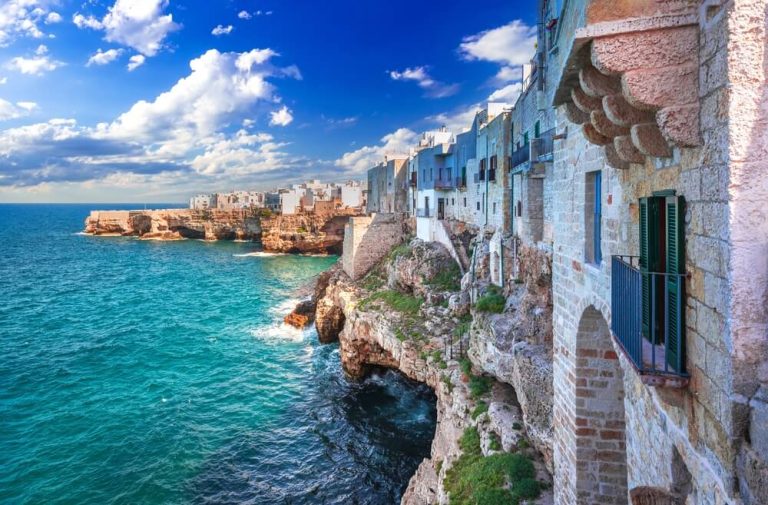
There is no doubt that the most famous restaurant in Polignano a Mare is the Ristorante Grotta Palazzese. A quick look at the reviews and you will see that this place has quite a marmite effect – you’ll either love it or hate it! What is for certain is that this place isn’t cheap – you’re certainly paying a premium for the incredible cave setting. We recommend you read the reviews and make up your own mind as to whether you want to try it.
Less controversial and highly recommended restaurants in Polignano a Mare include Antiche Mura and Terrazze Monachile which has a wonderful terrace with sea views. For the best gelato, definitely head to Gusto Caruso on Via Martiri di Dogali.
Things to do in Puglia
History and Culture
Puglia has a long and fascinating history, shaped by a multitude of different cultures. The ancient Greeks and Romans, the Normans, Byzantines and Swabians, the Spanish and the Bourbons have all exerted their influence on this beautiful region. And this melting pot of cultures is very much visible today.
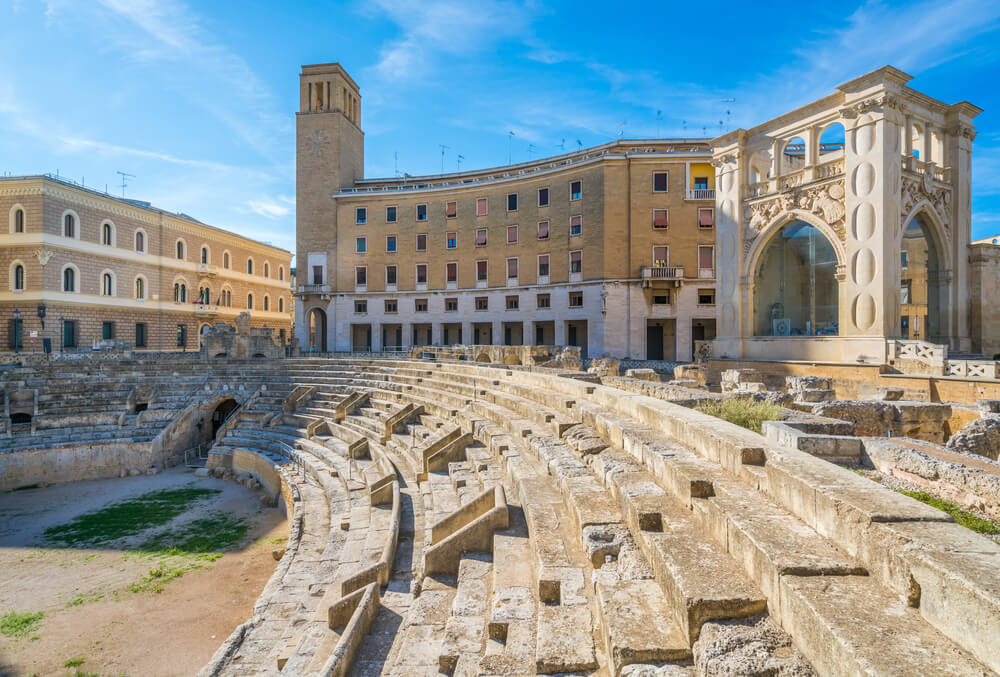
The ruins in Taranto are a great example of Puglia’s Greek history whilst those in Lecce are visible reminders of its Roman history. The Castel del Monte and the Basilica San Nicola in Bari are both superb examples of Puglia’s Medieval history whilst the Teatro Petruzzelli in Bari was a project of the Bourbon era, a period where there was extensive patronage of the arts and culture.
But of course, Puglia’s history extends beyond all these eras. Just outside Giovinazzo is the Dolmen of San Silvestro, a tomb dating back to the Bronze Age. Other tombs dating back to a similar period include the Dolmen Albarosa and the Dolmen di Montalbana between Ostuni and Fasano.
And if you want to go even further back again, then Altamura Man is a human fossil discovered in caves near Altamura. It dates to between 128,000 and 187,000 years old.
Vineyards and wineries
Think of Italian wine and Puglia probably doesn’t come uppermost to mind. Instead Tuscany usually does or perhaps Piedmont. However, Puglia is in fact Italy’s second top wine producer when it comes to volume, behind Veneto but ahead of Sicily and Emilia Romagna. Until the 1990s, much of the wine produced in Puglia would have been shipped north to boost the wines of southern France or the more famous vineyards of northern Italy. However, these days, things have changed and Puglia wines have a new found respectability. In fact, with plenty of sunshine and cooling sea breezes, Puglia is now a significant wine-making region. In fact, the region even has a museum dedicated to Primitivo wine in Manduria.
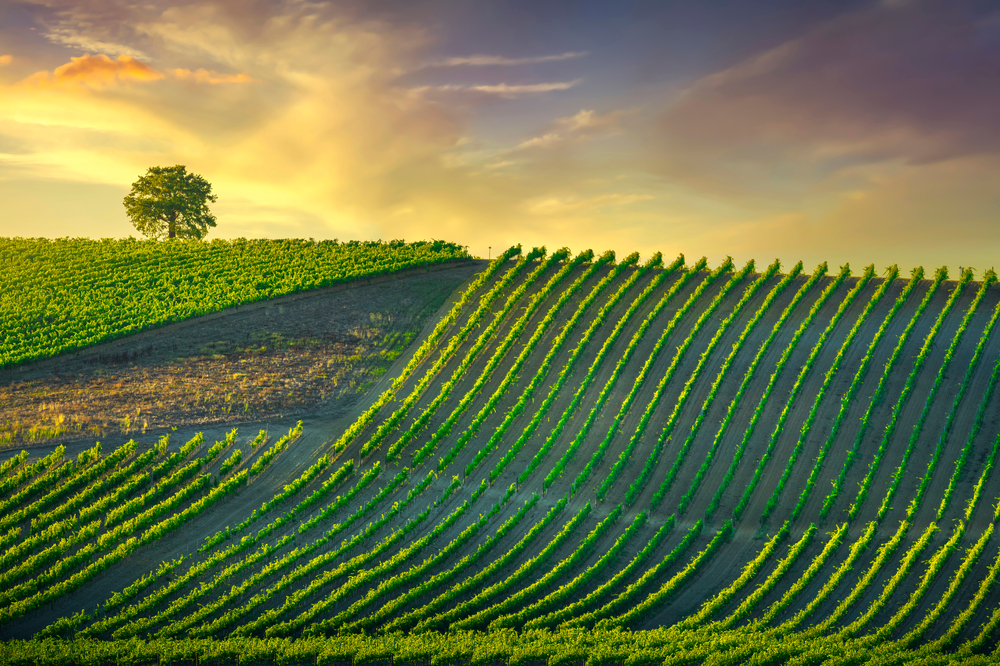
Puglia is famous for the production of full-bodied reds such as Negroamaro, Primitivo, Bombino Nero and Nero di Troia. Other wine varieties include Susumaniello and Salice Salentino. You can even find Montepulciano grapes in the north of Puglia near the border with Molise. However, it does also produce rose and white wines too. Fiano and Verdaca are both perfect for sipping on a hot sunny day.
Some of our favourite wine producers in Puglia include A Mano, Felline, Castello Monaci and Vallone.
Exploring the Puglia countryside
Puglia has some of the most beautiful rural landscapes anywhere in Italy. It is also incredibly varied. Puglia has two national parks. Furthest north is the Gargano National Park. This is the most extensive natural park in Italy. It encompasses the rocky spur jutting into the Adriatic Sea as well as the dense Umbra Forest, lush meadows, the limestone cliffs of the Tremiti Islands and the coastal lakes of Lesina and Varano. Heading south, you then have the Alta Murgia National Park with its rugged limestone plateaus and vast plains littered with ancient olive groves and Mediterranean scrubland. And then, in Puglia’s centre, the Valle d’Itria is characterised by rolling hills and ancient olive groves, dotted with charming whitewashed trulli. Nearby, there is the Terra della Gravine Nature Reserve. Here, the landscape is dramatic. Sixty canyons and ravines through which rivers would once have flowed stand as much as 500 metres above sea level. And again, it’s teeming with wildlife. And head to the south of Puglia and you have landscapes that include the Salt Basins of Margherita di Savoia. An enormous 20 km long and 5 km wide, it’s home to flamingos and other fascinating bird species.
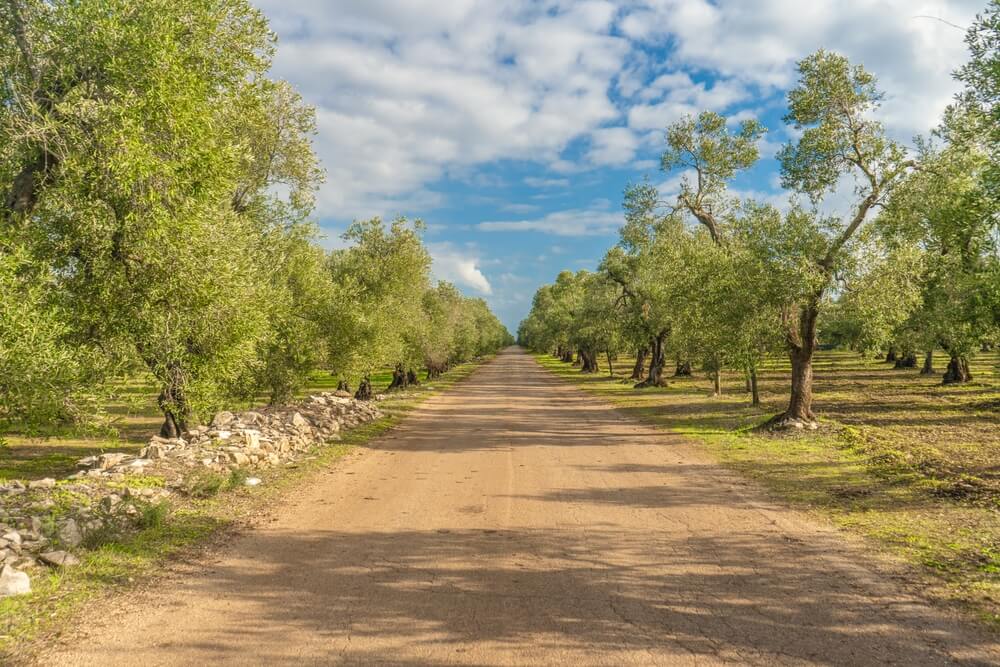
Whatever part of the Puglia countryside you choose to explore, you will find an abundance of wildlife, flora and fauna. There are numerous paths and trails for walking and hiking. But, even if you’re simply driving through the Puglia countryside en route from your Puglia villa to your sightseeing destination for the day, it’s a spectacular rural landscape to be admired and enjoyed.
Beaches
With over 500 miles of coastline and 27 Blue Flag beaches in 2025, Puglia is one of the best regions to enjoy a beach holiday in Italy. The coastline is incredibly diverse though. Puglia boasts small rocky coves (some of which can only be approached from the sea), long sandy stretches of pale white sand, quiet pebbled beaches and formal beach clubs lined with sun loungers and parasols. What they all do have in common, whether you’re sunbathing on the Adriatic Coast or on the Salento coast in the south, are the crystal clear, turquoise coloured seas. These seas are great for both snorkelling and diving.
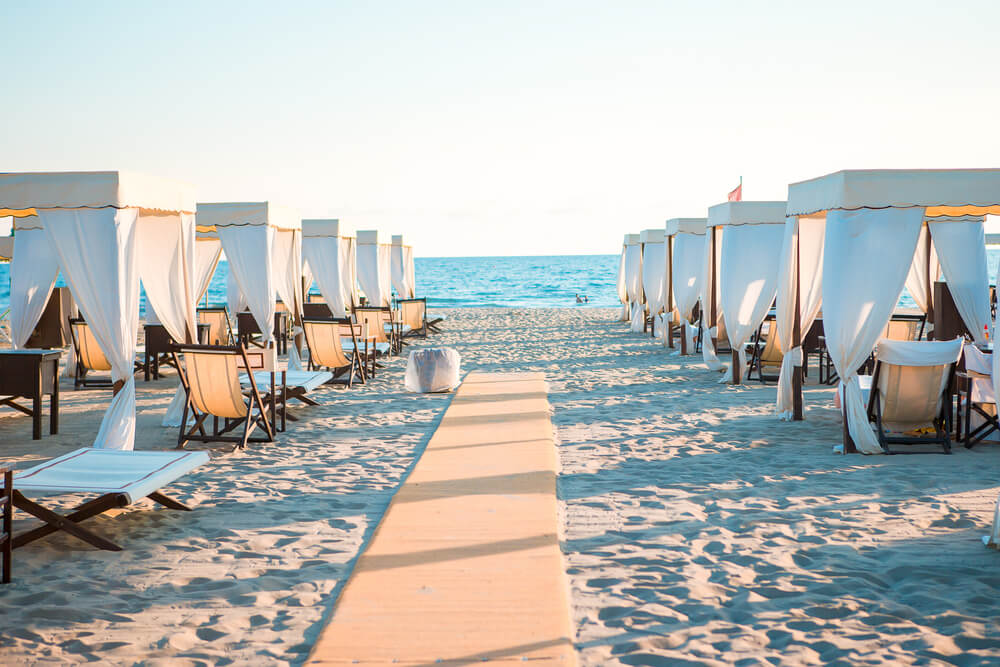
Some of Puglia’s most famous beaches are around Pescoluse in the southern Salento region. Here, so crystal clear is the water and so white and pale are the sandy beaches, that they have earned themselves the nickname of the ‘Maldives of Italy’.
In contrast, in the north of Puglia in the Gargano region, you have golden sands, white cliffs and pebbly coves. Here, the most popular and busiest beaches are around Peschici and Vieste, but if you are lucky enough to enjoy a boat trip, you’ll discover plenty of small coves where you can have the beach all to yourself.
Head further south from Gargano and you will arrive at Lama Monachile in Polignano a Mare. This is probably the most photographed beach in Puglia. And just north of Brindisi, you will discover several kilometres of beautifully unspoilt sandy beaches that forms the Torre Guaceto protected nature reserve.
Discover more about the beaches in Puglia in our guide to the top 10 beaches in Puglia to enjoy on your next Puglia villa holiday.
Best Places to Visit in Puglia
The towns and villages of Puglia – Alberobello, Bari, Brindisi, Lecce, Ostuni, Otranto, Polignano di Mare to name just a few – are all worth visiting on your next Puglia villa holiday. However, there are other sites in Puglia that should also make it on to your bucket list.
Grotte di Castellana
Measuring over 3 km long, the caves at Castellana are Italy’s longest natural underground network. Visitors have the option of a shorter 50 minute tour or a longer 2 hour path The highlight of both is the Grotta Bianca, a vast cavern measuring 100 metres long, 50 metres wide and 60 metres tall. Stalactites hang from the roof and stalagmites rise up from the ground. The most impressive formation of these is called Cyclops and sits in the centre of the cavern.
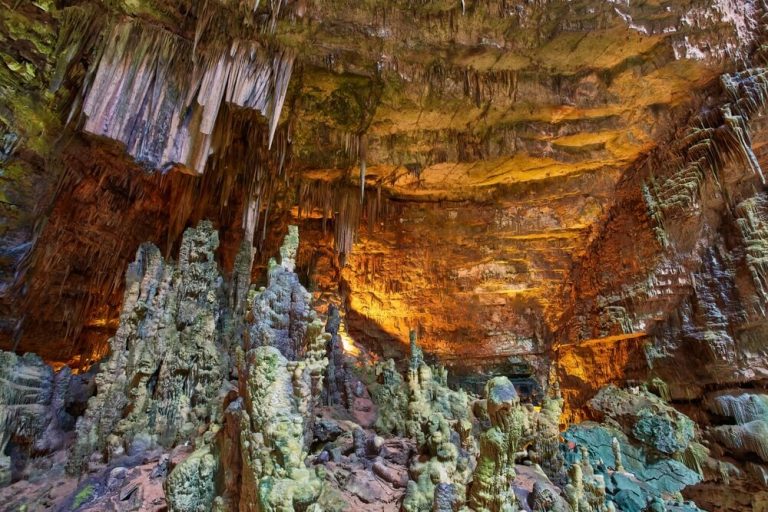
Gravina in Puglia
Gravina in Puglia sits approximately 60 km west of Bari within the Alta Murgia National Park. This ancient town is not unlike the much more famous Matera. In fact, whilst scenes from the opening sequence of the James Bond movie No Time to Die was filmed in Matera, the bridge Daniel Craig jumps off is, in fact, in Gravina in Puglia. On one side of this bridge is the Botromagno Archaeological Park where old monuments and churches are carved out of the rock. On the other side sits the old town and the breathtaking 11th century Romanesque Cathedral. At one of the smaller churches in the town – San Michele delle Grotte – you will discover a rather gruesome pile of skulls and bones. We recommend a walking tour of Gravina in Puglia and a visit to the underground caves.
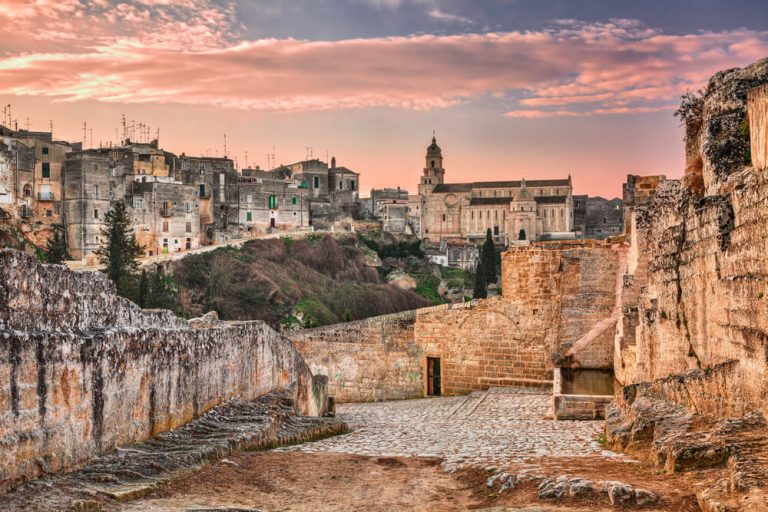
Pasta ladies of Bari
About 100 metres from the moat of Bari’s Norman castle is the Arco Alta, the entrance to Bari Vecchia. Here you will find ladies making pasta. These pasta ladies have industriously worked from their open kitchens for generations, spending days hand-crafting orrechiette, Puglia’s ear-shaped pasta. Wander through these streets and you will discover kilos of pasta drying on huge mesh trays, whilst the family washing hangs from balconies above.
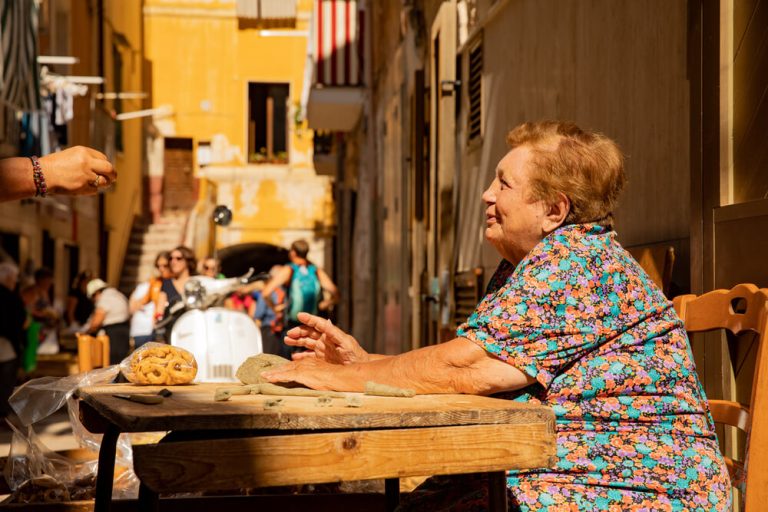
Tremiti Islands
The Tremiti Islands sit in the breathtakingly beautiful Gargano National Park in the north of Puglia, as does the Umbra Forest with its dense forests and thick, lush meadows.There are five small islands within the archipelago – San Nicola, San Domino, Capraia, Cretaccio and Pianosa. A boat journey from the mainland will take you to the islands in as little as 50 minutes. San Nicola is the heart of the archipelago. It is also the second largest inhabited island, home to monks, hermits and even prisoners over the years. However, we prefer the largest island – San Domino – whose coastline is dotted with caves. Capraia is much wilder and more rugged and is the best place to enjoy scuba diving. Both Pianora and Cretaccio are deserted. The former is heavily protected from an environmental point of view whilst the latter is supposedly populated by ghosts.
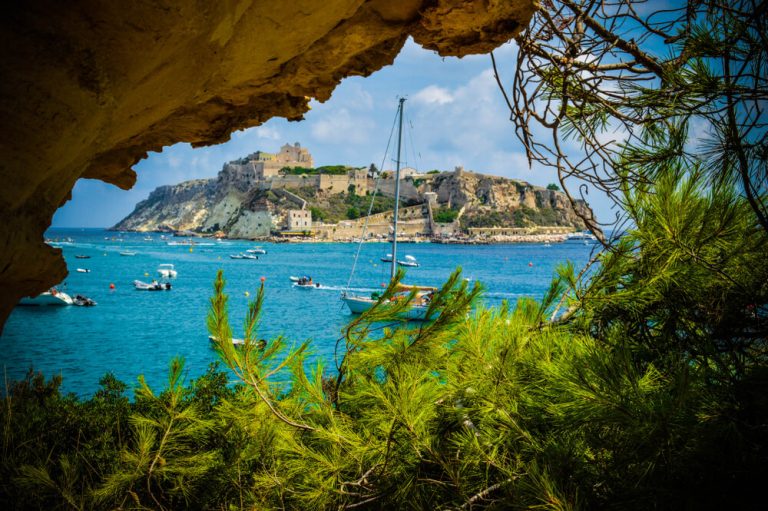
Grotta della Poesia
The Poetry Cave is a natural freshwater pool situated a 30 minute drive from Lecce. Whilst you once could dive from the cliffs that surround it into the crystal clear water below, swimming these days is strictly prohibited. However, it is still worth a visit. These dates, it forms one part of the Roca Vecchia archaeological site along with a fort and the Madonna of Roca Vecchia, a 16th century coastal defence tower. A short walk will take you to the second, larger part where you will discover the ruins of Bronze Age fortifications and Messapic walls.
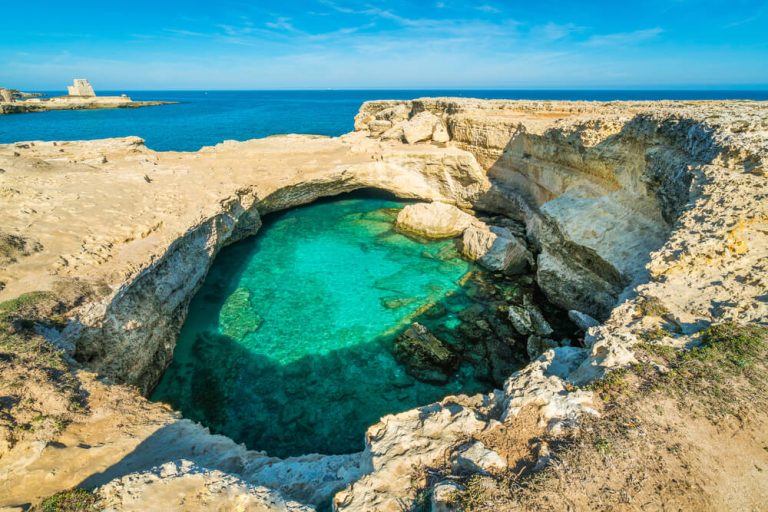
Trulli of Alberobello
One of Puglia’s UNESCO World Heritage sites, Alberobello’s trulli are an incredible example of drywall construction.Typically constructed from limestone blocks collected from the fields, they have domed or conical roofs. Whilst they can be found throughout the Itria Valley, they are to be found in the greatest concentration in the town of Alberobello. Here, over 1500 can be found in the two neighbourhoods of Rione Monti and Rione Aia Piccola.

Castel del Monte
Another of Puglia’s UNESCO World Heritage sites, the Castel del Monte is a 13th century octagonal shaped castle. Built for Frederick II, it is a unique example of military architecture that incorporates styles ranging from the Gothic to the Islamic Orient. Fun fact: The castle also appears on the Italian one euro coin.
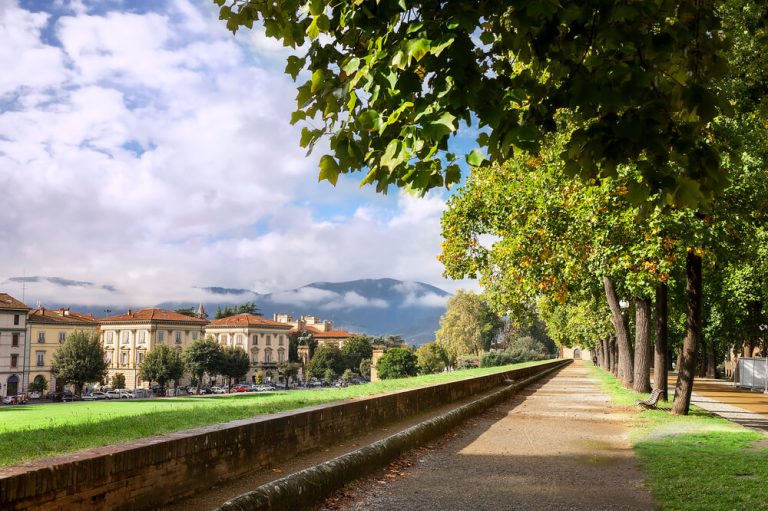
Altamura Man
Altamura Man is a fossil of the species Homo and one of the most complete Palaeolithic skeletons ever to be discovered in Europe. It was discovered in caves near Altamura in 1993. Subsequent testing has revealed that it dates to between 128,000 and 187,000 years ago. Still covered in a thick layer of calcite and embedded in stalactites, the incredible discovery was left in situ to avoid any damage when trying to move it. However, visitors can learn more and see videos and 3D images at the visitor centre there.
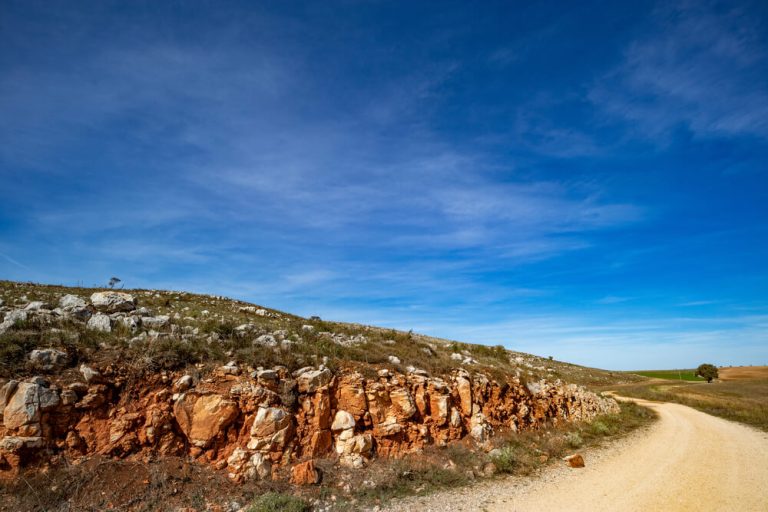
Monte Sant' Angelo
The third of Puglia’s UNESCO World Heritage sites, the Sanctuary of Sant’ Angelo sul Gargano is a cave where, according to legend, the Archangel Michael appeared. It forms part of a wider UNESCO site entitled the Longobards in Italy: Places of the Power.
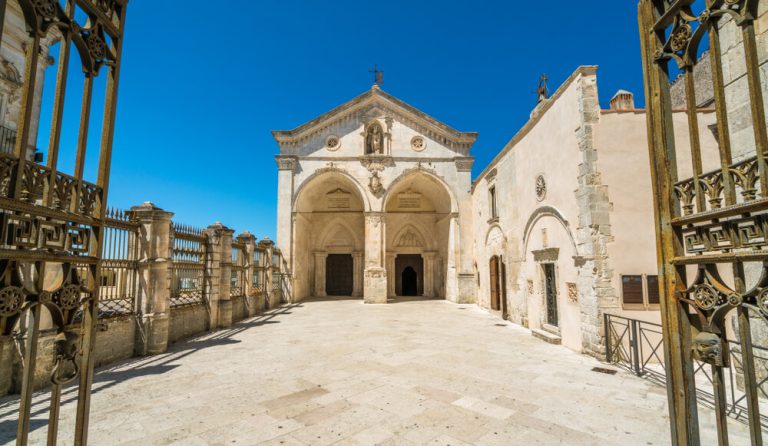
What to Eat and Drink in Puglia
As you can would expect from a region affectionately known as the ‘breadbasket of Italy’, Puglia serves up the most delicious food. There are plenty of regional specialities we recommend you trying during your Puglia villa holiday.
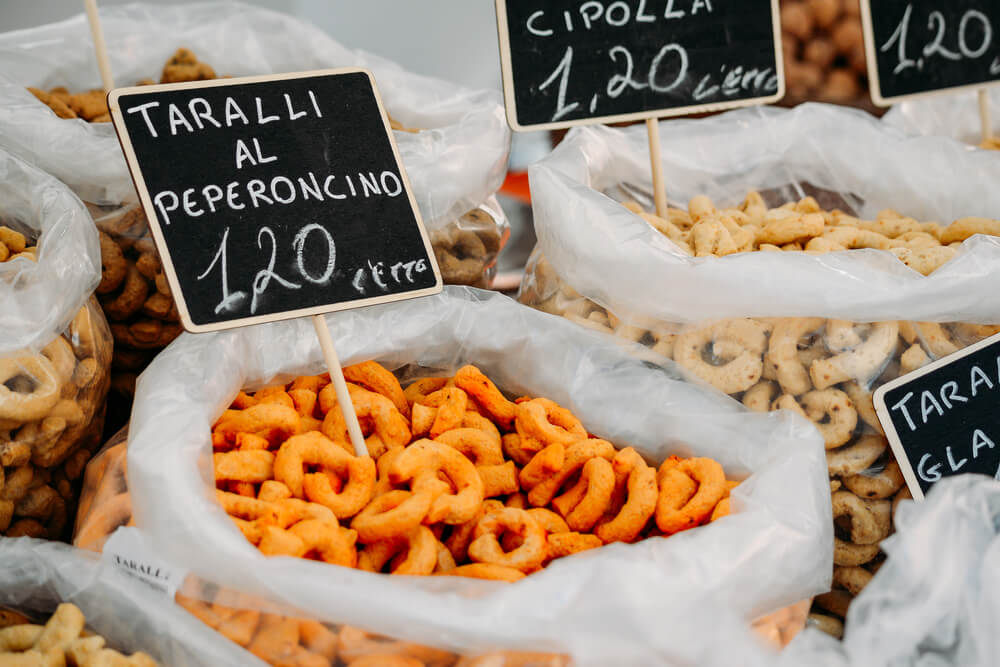
Orecchiete with Cime di Rapa
Orecchiette with cime di rapa is a traditional Puglian dish. Orecchiete is ear-shaped pasta. Cime di rapa is also known as broccoli rabe or rapini. A type of brassica, it has long leaves and small broccoli-like florets. But it has a bitterness to it that broccoli does not. Head to Bari to see the Italian grannies making the pasta by hand in the aptly named Strada delle Orecchiete.
Puglia also has a second pasta shape – troccoli. Not dissimilar to pici pasta, it is best described as a thick spaghetti like pasta.
Cheese
Puglia is home to a number of mouth-watering cheeses. Burrata is a delicious Italian cheese that originated in Puglia. It may look like a ball of mozzarella on the outside but inside it is filled with creamy stracciatella, fresh clotted cream and shredded mozzarella curds. It is softer, creamer and less elastic than mozzarella. Break into it and it is a delicious oozing gooey treat.
Other cheeses that originated in Puglia include the distinctive pear-shaped Caciocavallo Podolico. It is a stretched curd cheese made from a particular breed of Italian cattle – Podolico cows. If you find fried Caciocavallo cheese served with basil and tomatoes on the menu, definitely order it! It’s delicious!
Also specific to Puglia is Canestrato Pugliese, a hard sheep’s cheese as well as some types of ricotta cheese.
Bread
Travel around Italy and you’ll soon realise that each region of Italy boasts its own bread specialities. Puglia is no different. Its most famous bread – Pane di Altamura – has ancient origins and is easily recognised thanks to its thick crust which is at least 3mm thick. It was described by the Latin poet Horace as, ‘the best bread in the world’ and we would have to agree! Centuries ago, it would have been kneaded at home, baked in public ovens and used to feed peasants and shepherds who would have had to stay away from home for days. The thick crust would have kept the bread fresh for longer. Each family would have had a unique stamp so that they could distinguish one loaf from another. Interestingly, if you go to Altamura today, these public bread ovens still exist. And this same tradition of stamping the bread even continues in some families to this day too. These days, Pane di Altamura is also one of just nine Italian breads that has DOP (Protected Destination of Origin) status.
Puglia is also home to Focaccia Barese. Whilst not as famous as the Foccacia Genovese, this flat bread from Bari is absolutely delicious. It’s often prepared using a few different types of flour and also includes potato which gives it an extra springy texture. Find it in bakeries topped with tomatoes, olives or onions along with plenty of olive oil.
You will also find taralli in Puglia. Taralli are a type of dried bread. Perhaps best described as a circular breadstick, taralli are the perfect accompaniment to your aperitivo.
Bombette di Alberobello
Originating from the town of Alberobello in Puglia, bombette are small rolls of pork meat wrapped around caciocavallo cheese, salami and herbs before being roasted on skewers. We think they’re best tried in Alberobello itself or in nearby Cisternino at one of the barbecuing butchers!
Puccia
Another dish whose main ingredients are tomatoes and bread is the panzanella salad. Again, it’s a way Tuscans would traditionally have used up stale and dry bread but these days you may find it made using bread cut into cubes and toasted in the oven instead. This is the perfect dish to enjoy on a hot Summer day.
Raw Seafood
Another dish whose main ingredients are tomatoes and bread is the panzanella salad. Again, it’s a way Tuscans would traditionally have used up stale and dry bread but these days you may find it made using bread cut into cubes and toasted in the oven instead. This is the perfect dish to enjoy on a hot Summer day.
Pasticciotto
Another dish whose main ingredients are tomatoes and bread is the panzanella salad. Again, it’s a way Tuscans would traditionally have used up stale and dry bread but these days you may find it made using bread cut into cubes and toasted in the oven instead. This is the perfect dish to enjoy on a hot Summer day.
The Best Time to Visit Puglia
May, June and September are the best months to visit Puglia. We particularly love May and June – the Puglia countryside is still green and vibrant, with fields and roadside verges filled with the spectacular colours of wildflowers. May and June are also the best time to be on the beaches in Puglia. The sea temperature has already warmed up nicely and you will find the coast quieter than in July or August. But opt for September if you’re into wine. September temperatures in Puglia are similar to the Spring. However, September is the month when the vineyards start to produce the new wines of the season. And the colours of the rural landscape are beautiful at this time too.
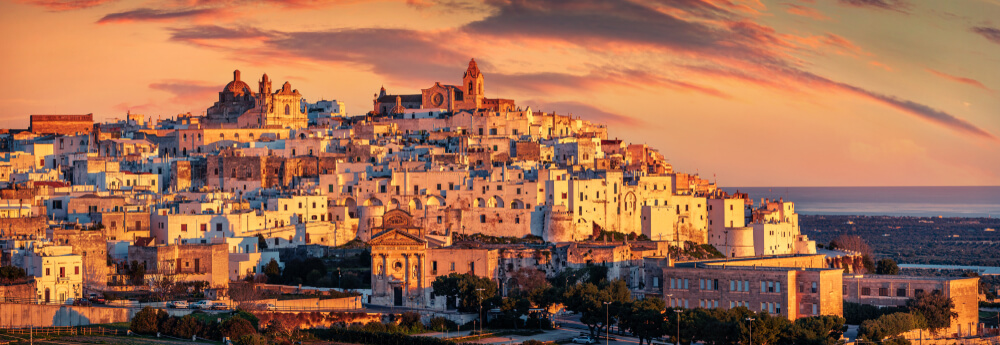
With average daily high temperatures in May, June and September sitting between 22°C and 26°C, and with minimal rainfall, it’s the ideal time for a Puglia villa holiday if you’re looking to enjoy outdoor activities such as hiking, cycling and sightseeing. In contrast, the Summer months can often be too stiflingly hot to do too much.
However, if you’re more into nightlife, then July or August can be a good time to go. This is when you will find the towns and villages sleepy during the day because of the heat, but come late afternoon and early evening, they really come to life. During these months there are a multitude of festivals in Puglia. Our favourites include the Festa di Santa Domenica in Scorrano from 5-8 July, the Alberobello Light Festival, the Sagra Pirotecnica dlla Valle d”Itria in Locorotondo and the Festa dei Martiri Idruntini in Otranto. All these celebrations make Puglia hard to resist in July and August although you should be prepared for larger crowds. Beach life also continues across these months – temperatures in Puglia at this time can consistently sit around 32°C so the coast is the coolest place to be.
Visit Puglia in March, April or October if you’re looking to discover this region without the crowds. The weather still tends to be extremely pleasant at this time and it’s a great time to really explore all the sights of this beautiful region.
Don’t rule out a Puglia villa holiday in the Winter though. Between November and March, average high temperatures still sit comfortably in the low to mid teens. Exploring the villages and towns of Puglia during the festive season gives your sightseeing an extra magical feel. That said, if you’re looking to minimise the chances of rain, you’re best visiting between January and March rather than at the tail end of the year as November and December are the two months with the highest average rainfall.
How many days do you need in Puglia?
Puglia is not a destination you can do justice to in just a couple of days. It’s over 400 km from the north to the south of Puglia and within this vast space, there are four sub-regions to explore. These are the Gargano Peninsula, the Alta Murgia, the Valle d’Itria and the Salento region.
The Gargano Peninula is a mountainous area with dense forests, home to the first of Puglia’s UNESCO World Heritage sites– the Monte Sant’ Angelo. It also boasts a spectacular coastline. Take the coastal road between Peschici and Mattinata and keep an eye out for the trabucchi. These are old wooden fishing structures, some of which have more recently been converted into wonderful restaurants.
The Alta Murgia is much wilder, hilly region. It’s also home to the second of Puglia’s UNESCO World Heritage sites – Castel del Monte – and to fascinating towns such as Trani and Andria.
The Valle d’Itria is picture-postcard Puglia. Twisted olive trees puncture the beautiful countryside whilst the whitewashed houses of towns such as Ostuni, Alberobello (another UNESCO site), Cisternino, Locorotondo, Pescaria and Polignano a Mare contrast with the blue skies above.
Last but not least, Salento is home to the beautiful Baroque town of Lecce as well as to Gallipoli and Otranto. It’s the beaches that really sets this region apart from the rest of Puglia though. The turquoise waters are even more crystal clear and the beaches even more idyllic.
In short, Puglia is incredibly varied and it would definitely need at least a week to truly appreciate its diversity. That said, if you don’t have much time, there are still some great Puglia villa holidays you can enjoy.
At Bookings For You, we’d be delighted to help create a bespoke itinerary for your Puglia villa holiday. Our itineraries will be tailored to the location of your villa in Puglia and whether this is your first visit or whether you’re returning seasoned holidaymakers.
3 Days in Puglia
If spending just 3 days in Puglia, choose your base smartly and you could easily manage to discover this region without a car. For example, opt to stay in Bari and you can explore the city for one day and on the other two, you could catch a direct train to towns such as Alberobello and Cisterino. Alternatively, you could head along the coast to explore other coastal towns such as Polignano di Mare, Monopoli or Lecce. If you choose to hire a car, you could instead enjoy day trips from Bari to attractions such as Castel del Monte (which is harder to reach using public transport but not impossible) or the Grotte di Castellana. Both are within an hour by car from Bari.
Of course, the base for your 3 day Puglia villa holiday does not have to be Bari. You could choose any Puglia town or village. We tend to recommend opting for something in heart of the Valle d’Itria though as there are plenty of sights within an easy radius. Alternatively, if you’re a beach lover and simply want some lazy days in the sun, you could choose any of the seaside towns in Puglia and just sit back and relax on the sand for 3 days!
5 Days in Puglia
With only 5 days in Puglia, you will still have to make some difficult decisions about what to include and what to cut out of your Puglia villa stay. If it’s your first time visiting Puglia, our advice would always be to base yourself in the Valle d’Itria as this is usually the area of Puglia that holidaymakers have in mind. Plus, that way, you’re within easy reach of towns such as Alberobello, Martina Franca, Cisternino, Locorotondo, Ostuni, Polignano a Mare and more. Dependent on the pace in which you tend to explore, you could still find time to head down to Lecce for the day. After all, the drive from Ostuni to Lecce only takes an hour.
We’re big fans of slow travel, taking your time to properly engage in the local culture rather than rushing from one place to another. An example itinerary for 5 days in Puglia that fits with this approach could be to visit Ostuni on day 1, Alberobello on day 2 and Polignano a Mare on day 3, stopping to admire the Grotte di Castellana en route. For day 4, you could either explore Cisternino, Locorotondo and Martina Franca, or you could opt for a ‘rest day’, instead heading to one of Puglia’s beaches. And finally, on day 5, you could head south to explore Lecce. Opt to just go for the day or spend the night there.
If you’re keen to explore a wider area of Puglia, then an alternative 5 day itinerary could be to spend day 1 on the coast. Start with a morning in Bari before working your way down to Polignano a Mare for the afternoon and Monopoli for the evening. On day 2, head to Alberobello early to explore before the crowds descend, before visiting Ostuni. If you have time, squeeze in a visit to Cisternino and Locorotondo en route between the two. Mix it up on day 3 by heading across into neighbouring Basilicata to visit Matera. If you want, you could stop at Altamura on the way. However, we do recommend a full day in Matera to do it justice. For your fourth day in Puglia, head further south to Lecce and Otranto on the Adriatic coast. This will be your first taste of the Salento region of Puglia which has a completely different look and feel to the Valle d’Itria. Last but not least, spend the final day exploring the Ionian Coast to the west of Puglia. A nice stop on the way to Gallipoli would be in Manduria to enjoy some wine tastings in the home of Primitivo!
7 Days in Puglia
If you have one week in Puglia, then it’s the perfect length to discover the area around Bari, the Valle d’Itria and part of the Salento coast. Like our 5 day Puglia itinerary, this 7 day itinerary has intentionally included a mix of sites, from Puglia’s cities to charming small towns and villages, along with the beautiful countryside and beaches. You have 2 options – you can choose to move accommodation, with 1-3 nights in each location. But our suggestion is to have just one or two bases instead. Use our 5 day itinerary, but extend your time in Bari and add in a stop at the Grotti di Castellana. Base yourself in one of our Puglia villas in the countryside and then head down to Lecce for a couple of nights. Lecce is always best seen in the evening when the town comes to life so enjoying an overnight stay here can work really well. Whilst here, you can also add on a stop at the Grotta della Poesia and explore the beautiful Puglia beaches.
10 Days in Puglia
10 days in Puglia allows ample time to not just explore Puglia but also to head across the border to neighbouring Basilicata and discover Matera. With the extra time that 10 days in Puglia gives you, you can also definitely afford to stop in Gravina in Puglia and the Alta Murgia National Park on your way to Basilicata.
You can opt to enjoy our 7 day Puglia itinerary and just slow the pace a little. But it you’re someone who likes to be constantly busy, then you could also choose to spend the extra days heading further south again. The drive from Otranto to Santa Maria di Leuca at the southern tip of Puglia is some of the most breath-taking coastal scenery anywhere in Puglia.
14 Days in Puglia
With 14 days, you could add a third region of Puglia to your holiday itinerary. Start your trip with two or three nights in either the Gargano Peninsula or Alta Murgia before then picking up our 10 day itinerary. This will give you time to discover one of Puglia’s other UNESCO World Heritage sites – Sant’ Angelo sul Gargano – or even the opportunity to visit the beautiful Tremiti Islands. Just remember when planning your itinerary that Puglia is Italy’s 7th largest region. The drive from either Tremoli or Vieste in the north down to Santa Maria di Leuca in the south is nearly 450 km long. Factor in how tiring driving long distances can be on your holiday and don’t stretch yourself too thin!
Instead, a more relaxing 2 week itinerary for Puglia could be to spend one busier week sightseeing within the Valle d’Itria and spend the second week relaxing on the beaches of Salento. Again, we would recommend you include a trip to Matera in a 2 week holiday in Puglia.
A Month in Puglia
If you’re lucky enough to spend a month in Puglia, then we’re, frankly, extremely jealous! This way you can spend a week in each of Puglia’s sub regions and enjoy discovering each at a slower pace. Work your way down from the Gargano Peninsular through to the Alta Murgia and the Valle d’Itria before finishing in Salento. The landscape in Puglia is so diverse that this will inevitably feel like four separate holidays by the time you head back home.
Puglia holidays for...
Puglia ticks so many boxes that it can have a broad appeal. Whether you’re 8 or 88, there is something in Puglia for everyone to enjoy. That said, we have some great ideas about the best Puglia holidays for different travellers.
For Couples
We think Puglia is one of Italy’s most romantic destinations. Both its white-washed towns dotted with candlelit restaurants, and its idyllic coastline ooze romance. Gaze into each others eyes over some of Italy’s finest food, stroll hand in hand through charming villages, go wine tasting in the Valle d’Itria, or opt for a private swim in a hidden cove. And stay in one of Italy’s most romantic settings. A restored trullo or an intimate Puglia villa is the perfect setting to enjoy each other’s company in complete privacy and seclusion.
For Families
A Puglia villa holiday is a dream destination for families. First and foremost, children and teens will love the beaches in Puglia. Calm, crystal-clear, turquoise seas are calm and shallow for little ones, whilst older ones will delight in the snorkelling and water sports on offer. The towns of Puglia are also a delight for families to discover and there are plenty of other family-friendly days out in Puglia too. Opt for a day at the water park or on the roller-coasters of Zoosafari Fasanolandia. Cool off in the caves or enjoy a boat trip to spot the dolphins. Enjoy a cookery lesson or meet the pasta grannies of Bari. Discover dinosaurs or explore the hobbit houses of Alberobello. There really is so many family days out in Puglia.
We also think that the slower pace of life in Puglia is the perfect opportunity for families to relax and unwind. A spacious Puglia villa with private pool and outdoor dining area is ideal. Families can enjoy both privacy and room to relax after days spent sightseeing.
Solo Travellers
For solo travellers seeking tranquility and authentic Italian charm, Puglia offers the perfect escape. Solo travellers can wander at their own pace through Lecce’s Baroque streets, join a cooking class, or simply unwind by the sea with a book.
If travelling solo in Puglia, we often recommend choosing a location with good public transport links. Whilst driving in Puglia is easy most of the time, it can be stressful if travelling on your own. Instead, we think it’s much more relaxing to go by train. A larger town such as Bari can be a good option as there are good accommodation options for all budgets. It’s also a city where you can easily meet others if you want to connect with fellow travellers on your trip.
Alternatively, an apartment in Ostuni can also be a lovely base for a solo stay. Or opt for a smaller luxury villa in Puglia or a stylish countryside retreat. This can be both peaceful and enriching, guaranteeing privacy whilst still offering easy access to nearby villages and cultural attractions.
For Groups
We think that renting a large villa in Puglia in the heart of the countryside is a great option for gatherings of friends or extended families. You’ll be able to enjoy the privacy and space that a self-catering villa offers whilst enjoying the wealth of cultural attractions that Puglia offers. Large villas in Puglia with pools and expansive gardens create the perfect setting for a memorable group stay. We recommend you hire a private chef to cook for you so that everyone can put their feet up and relax.




